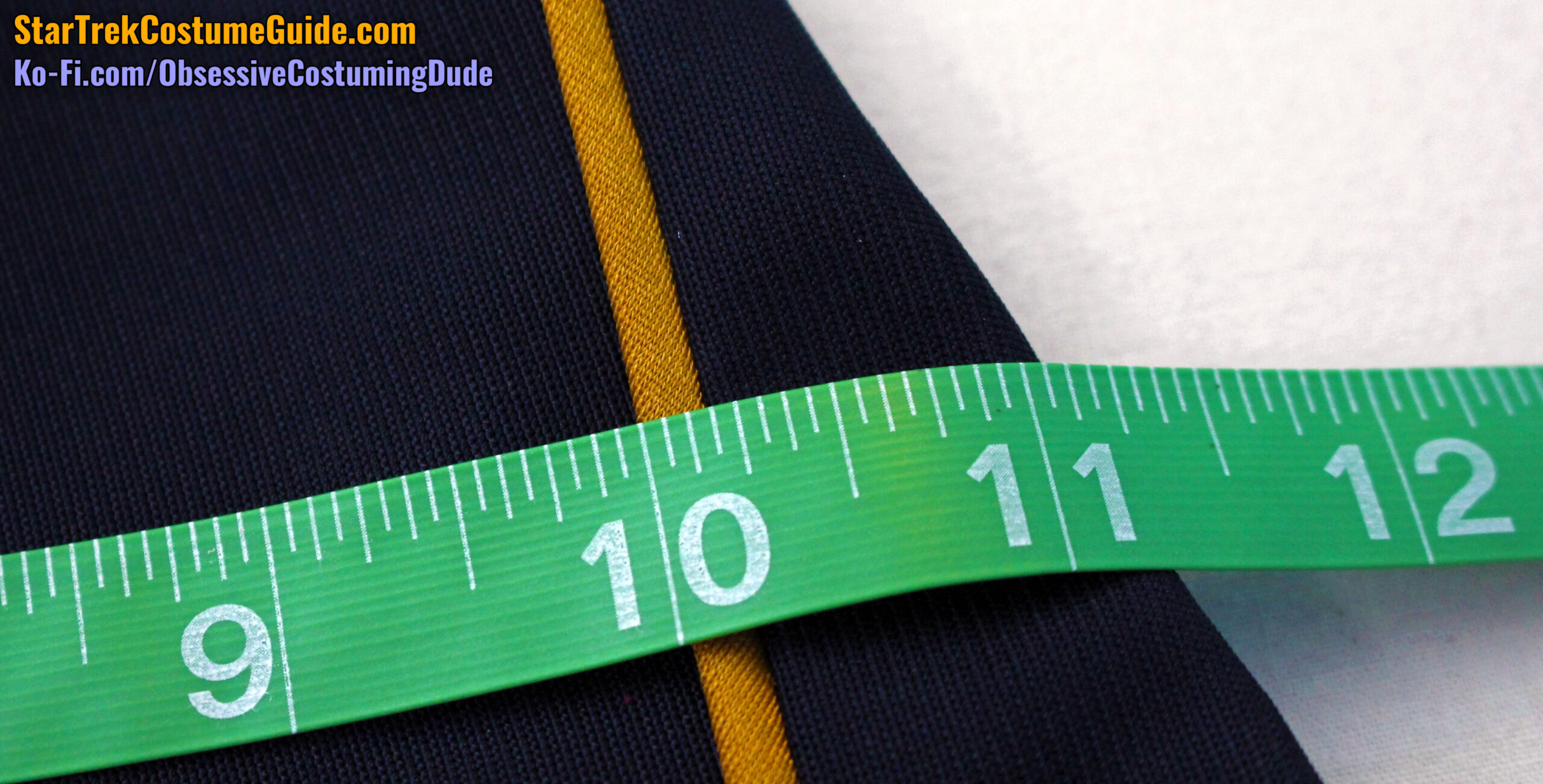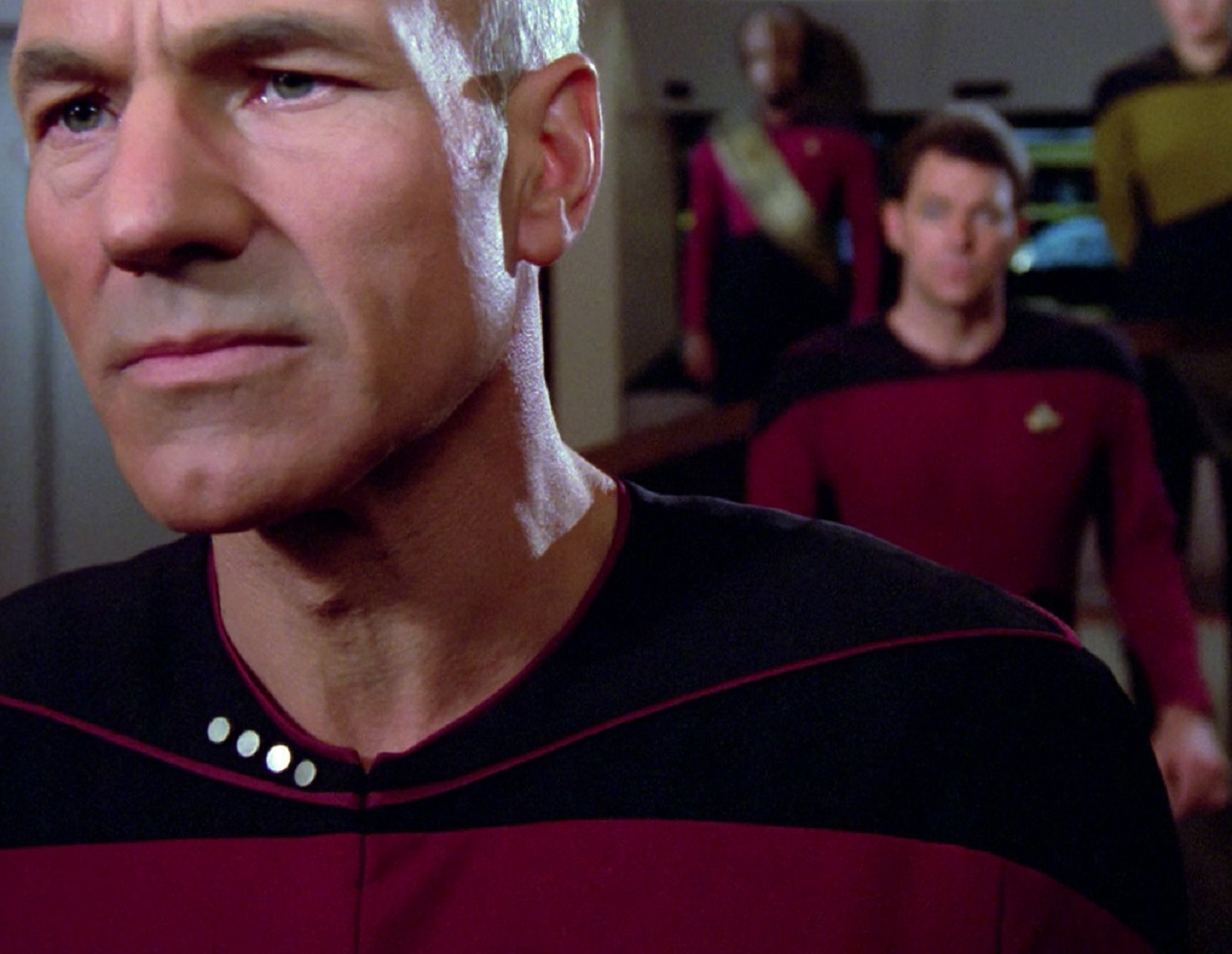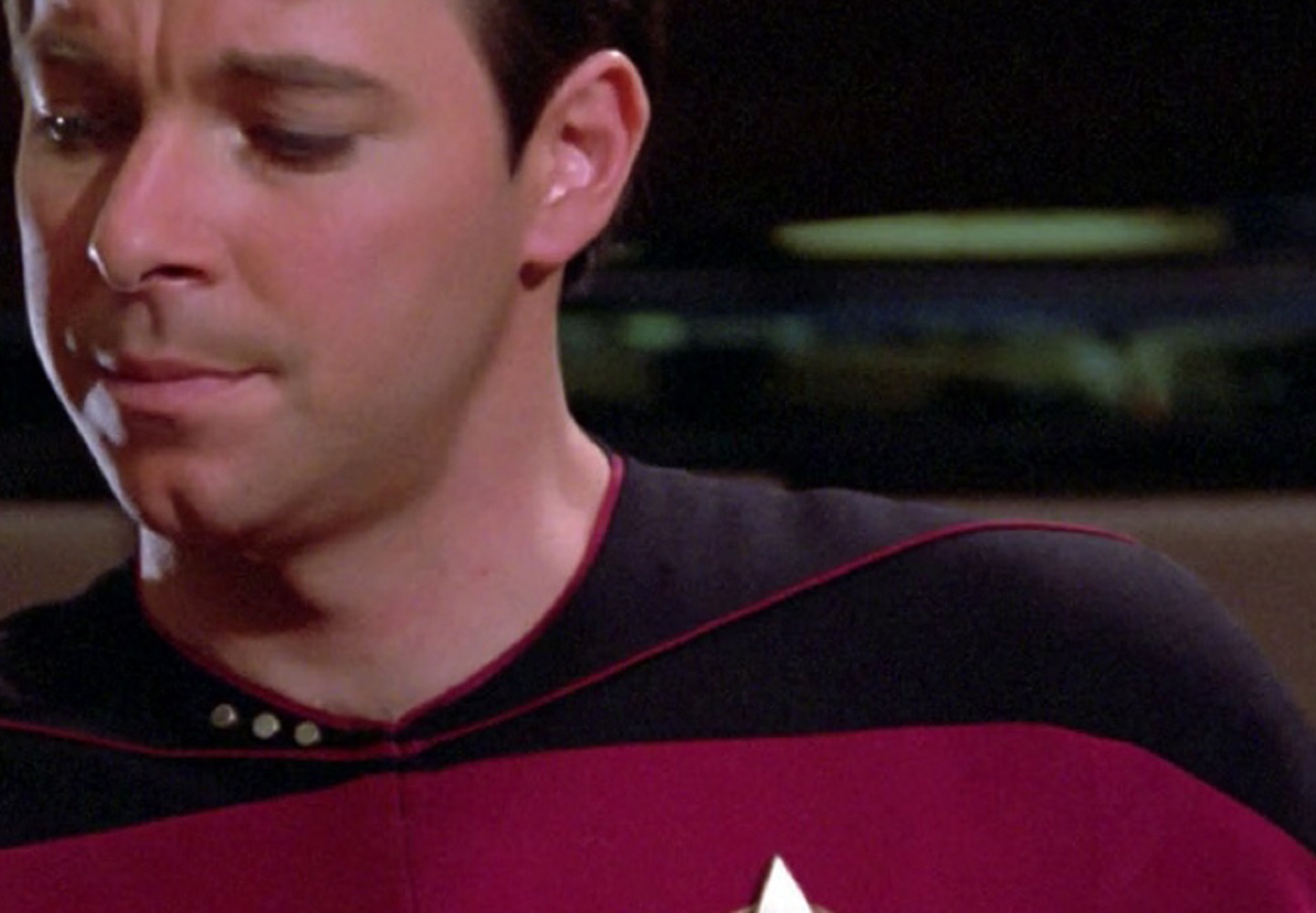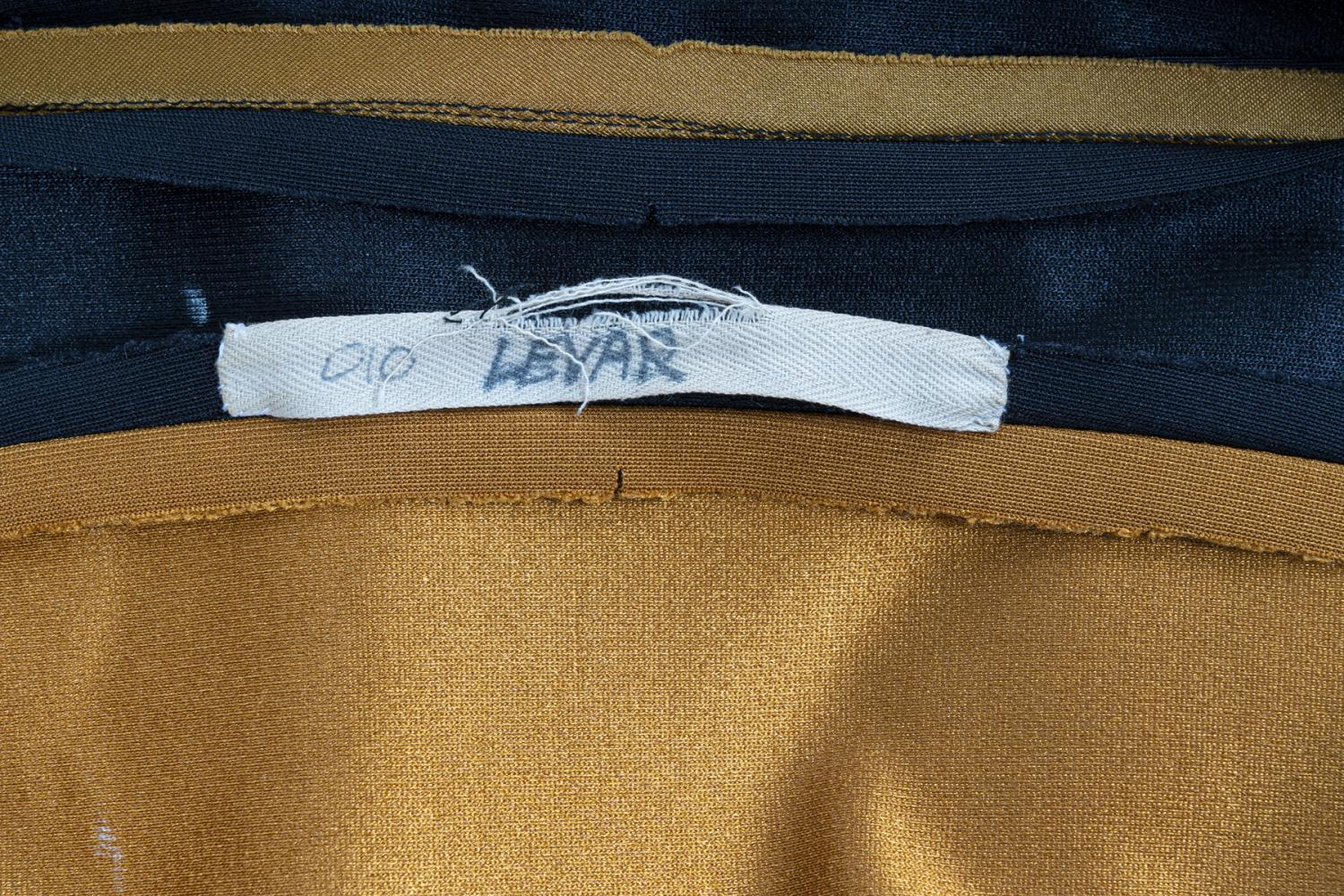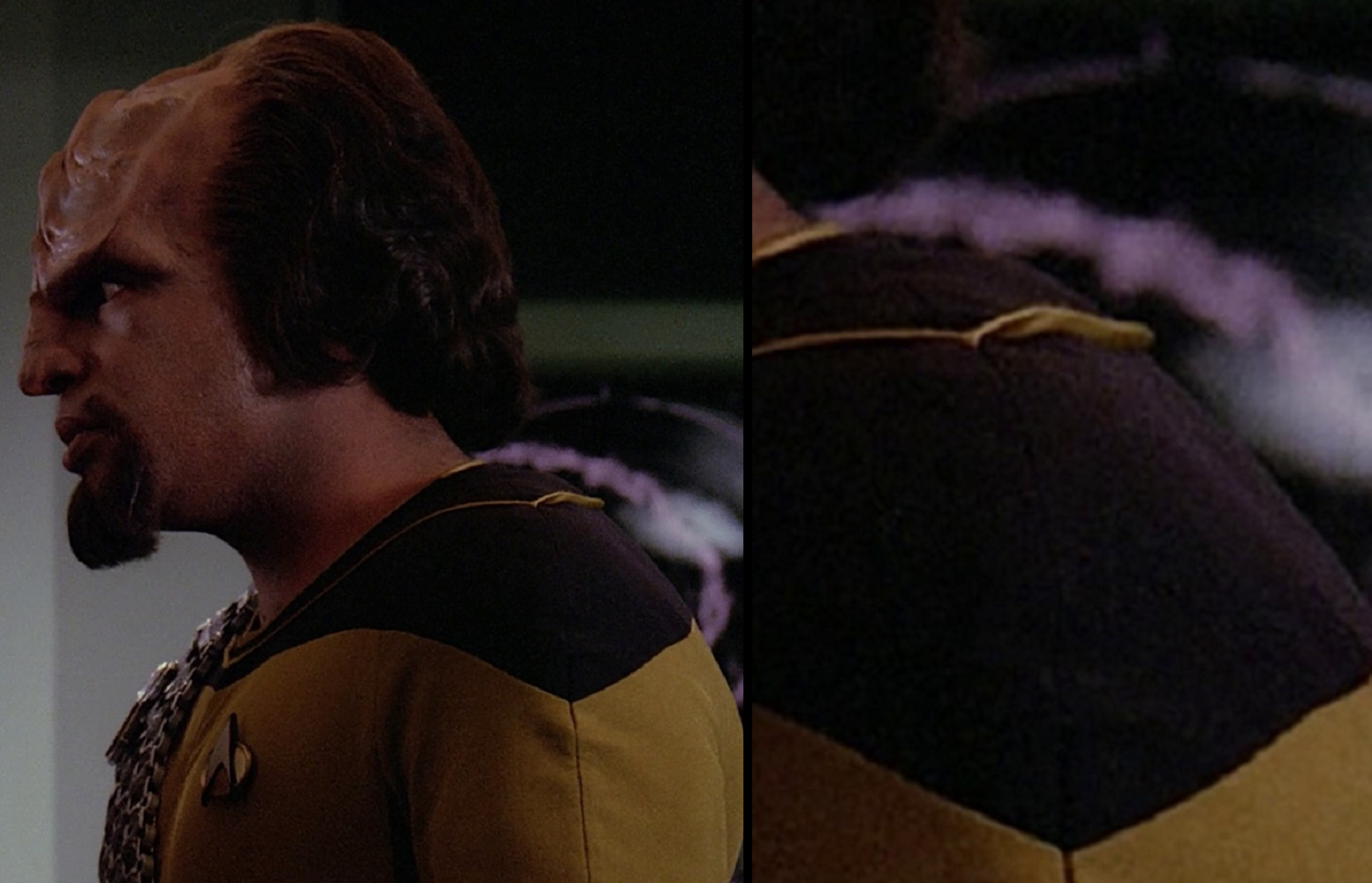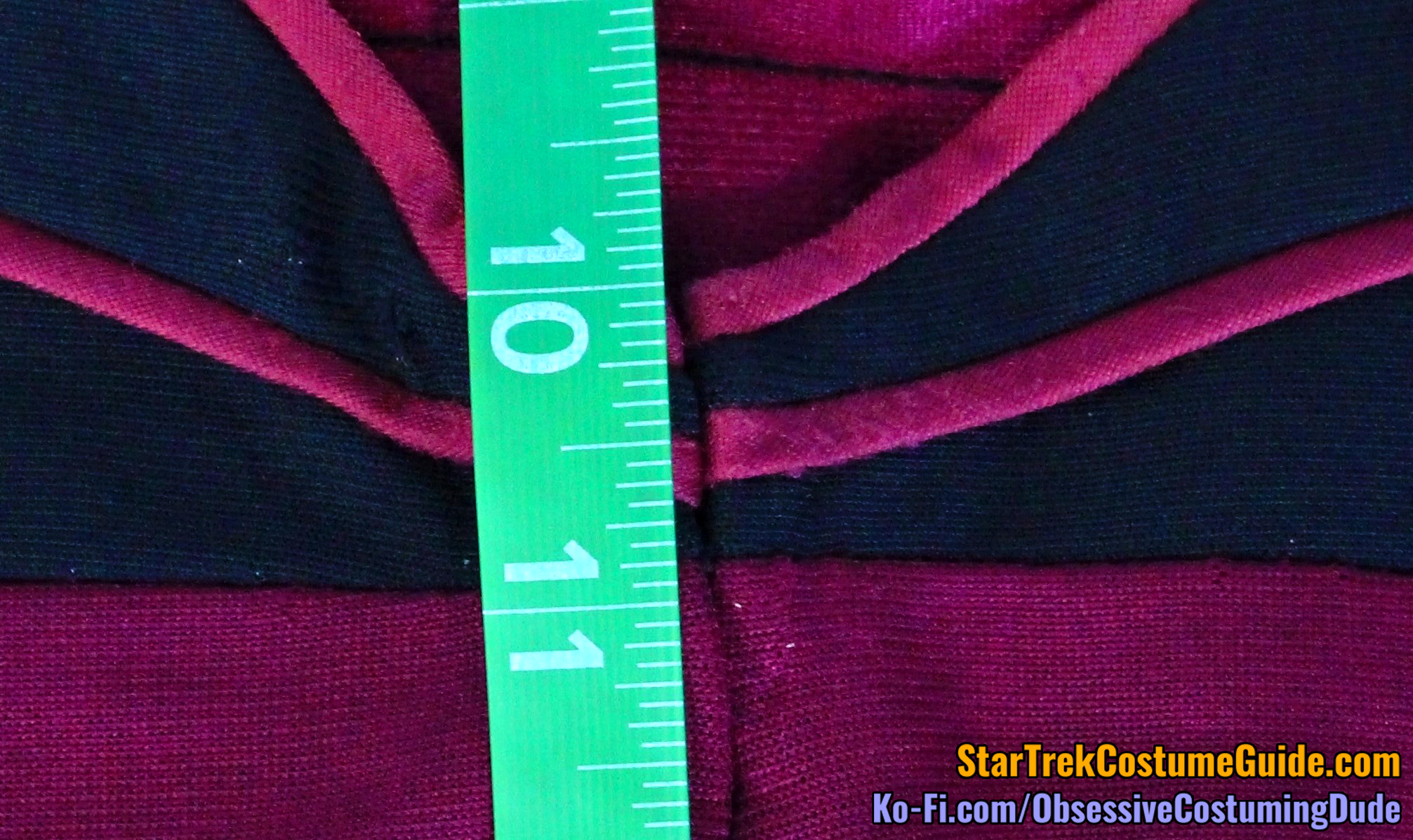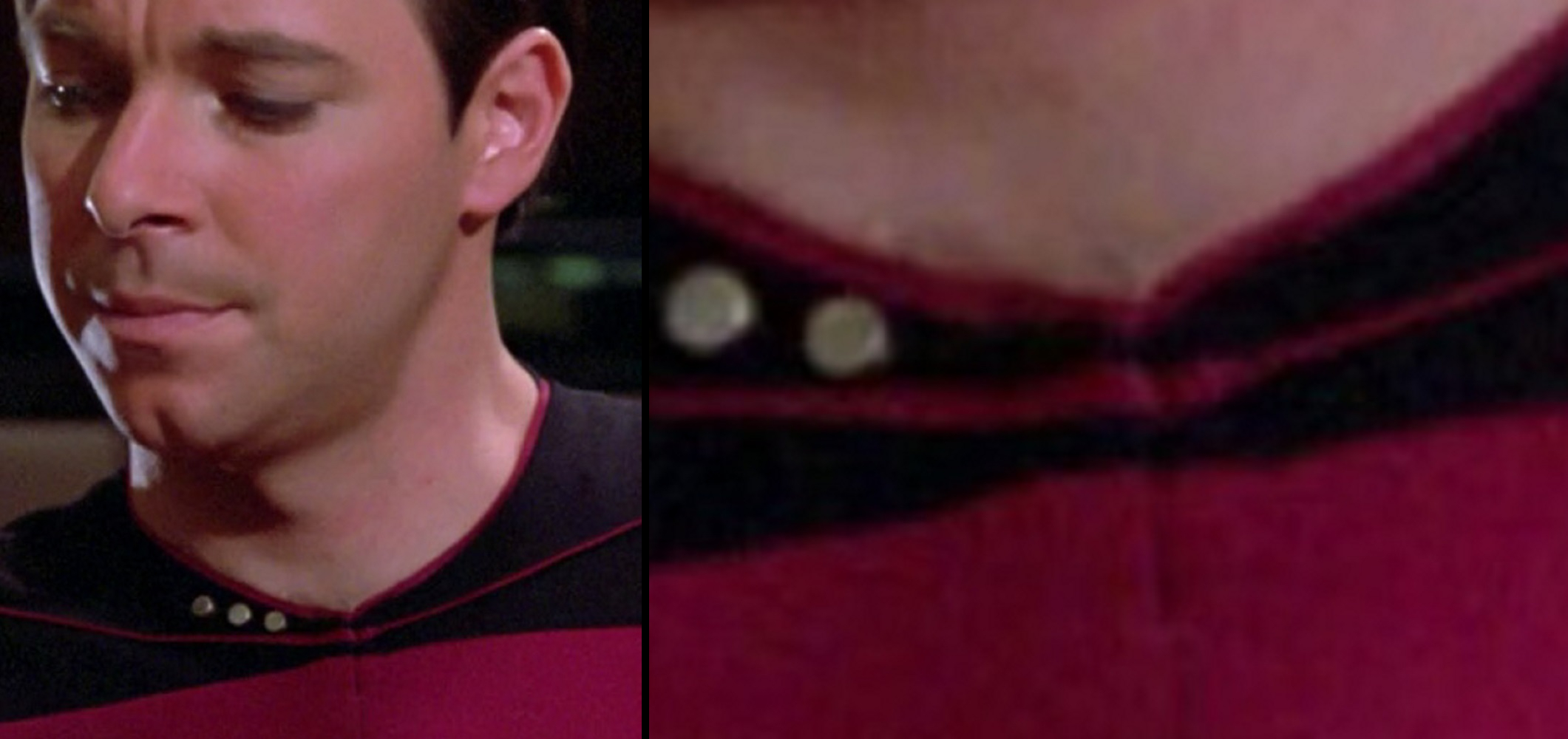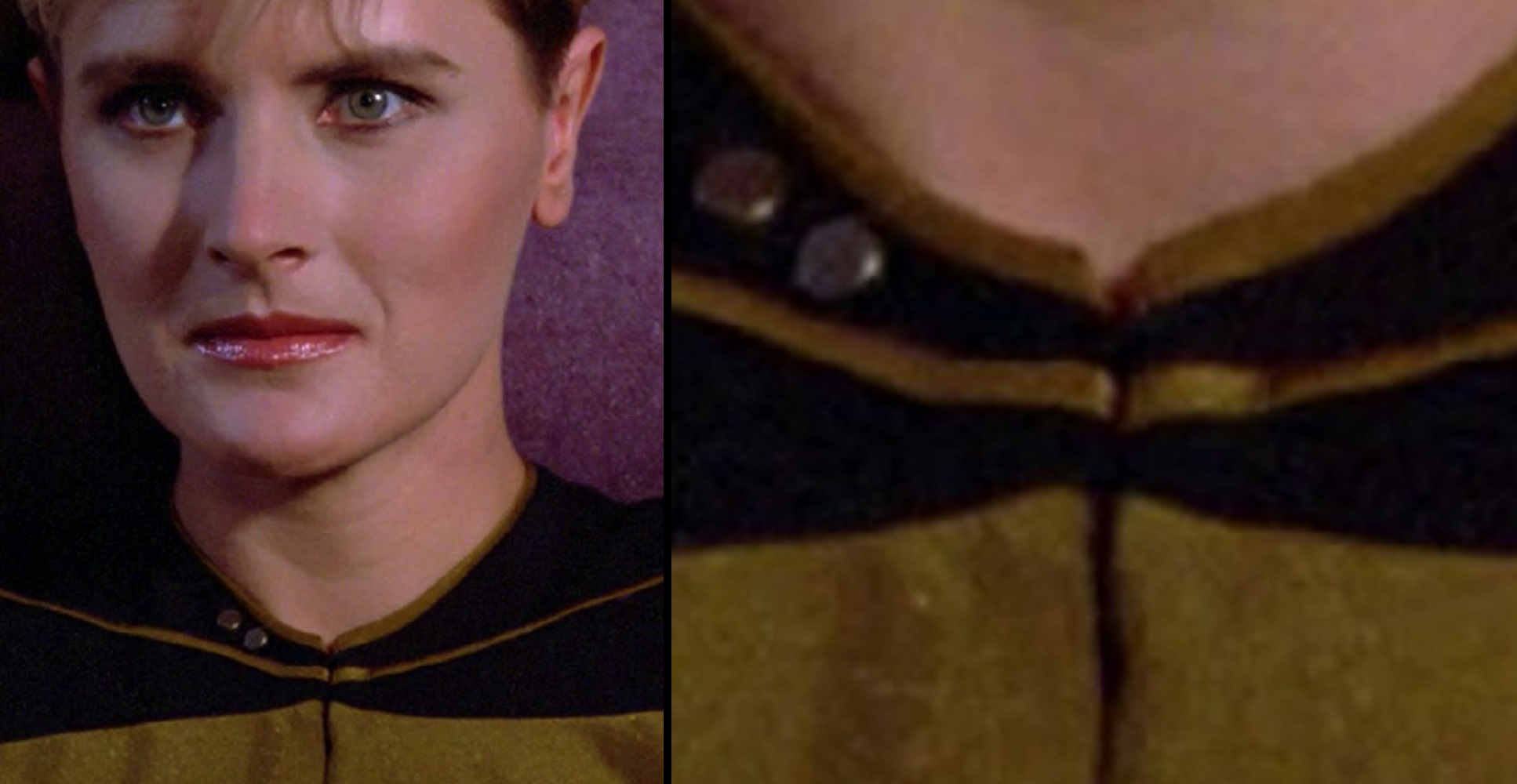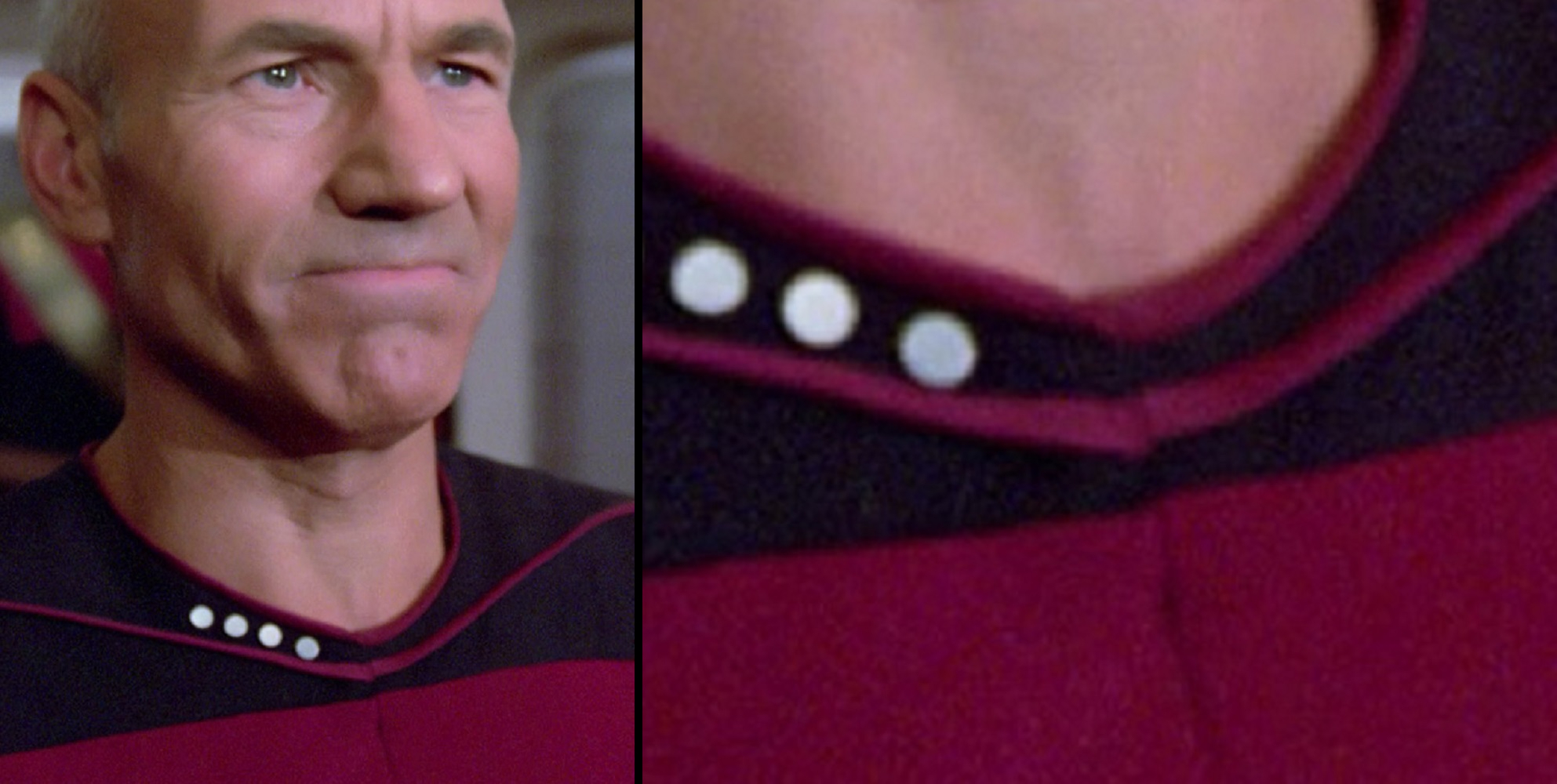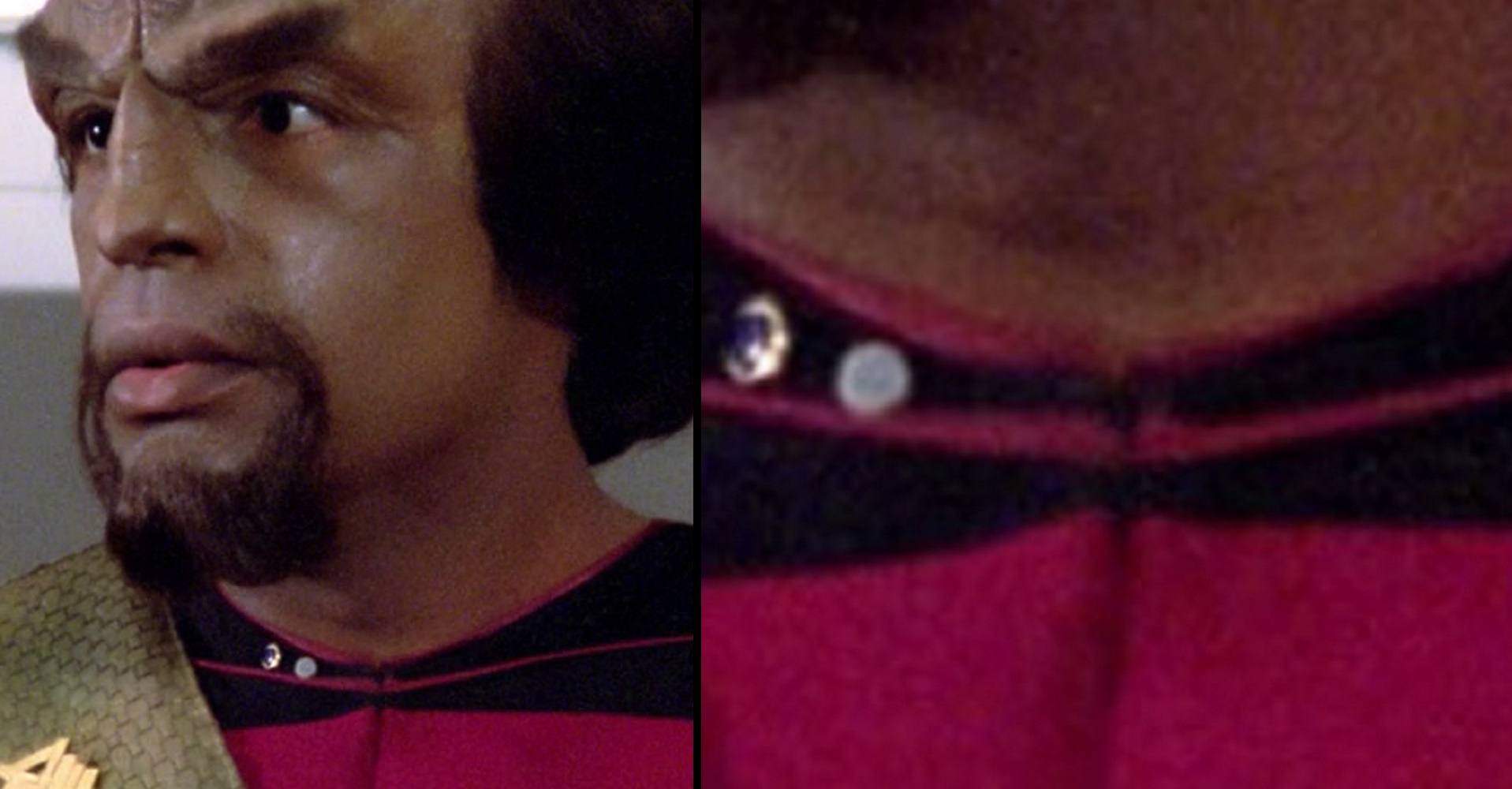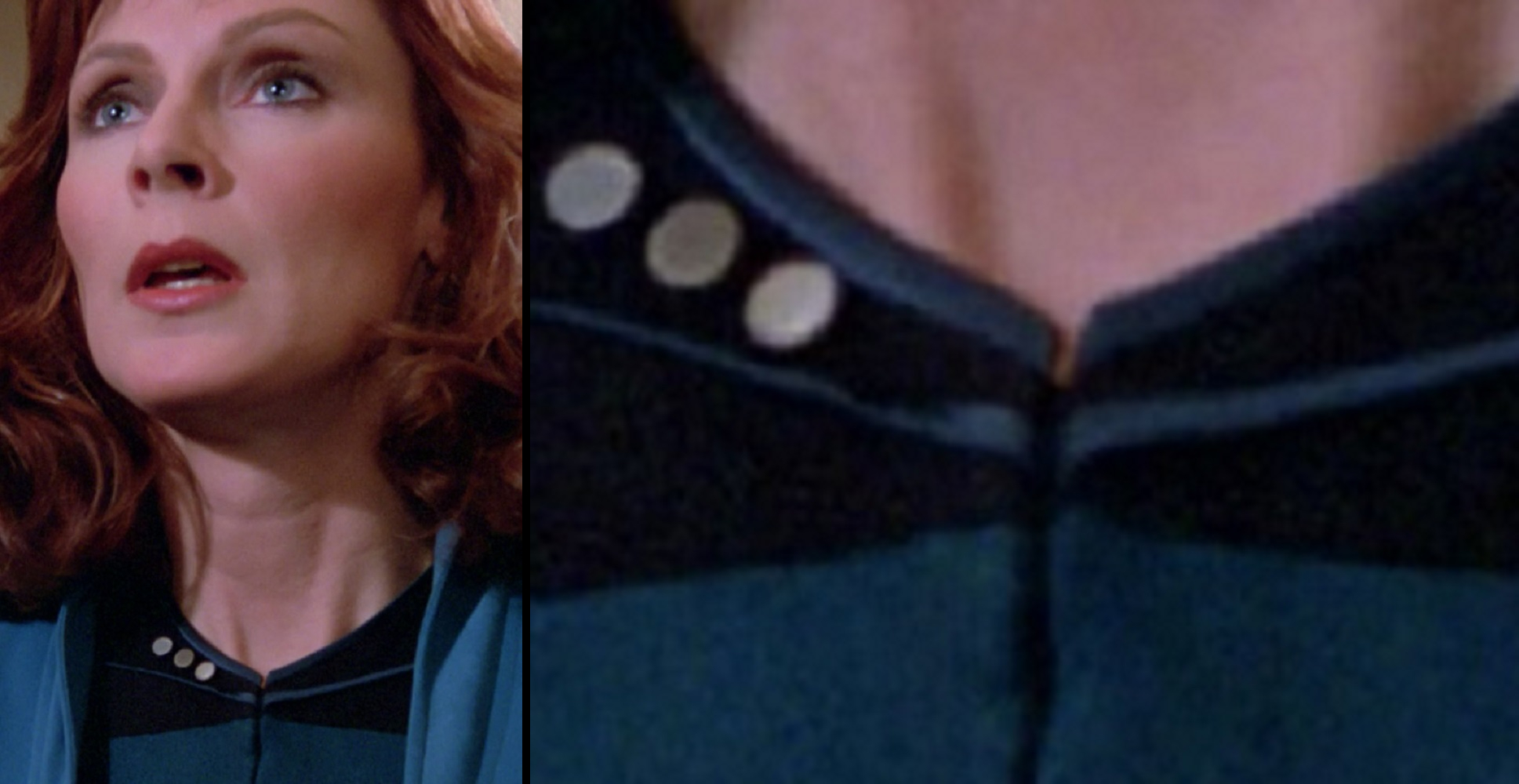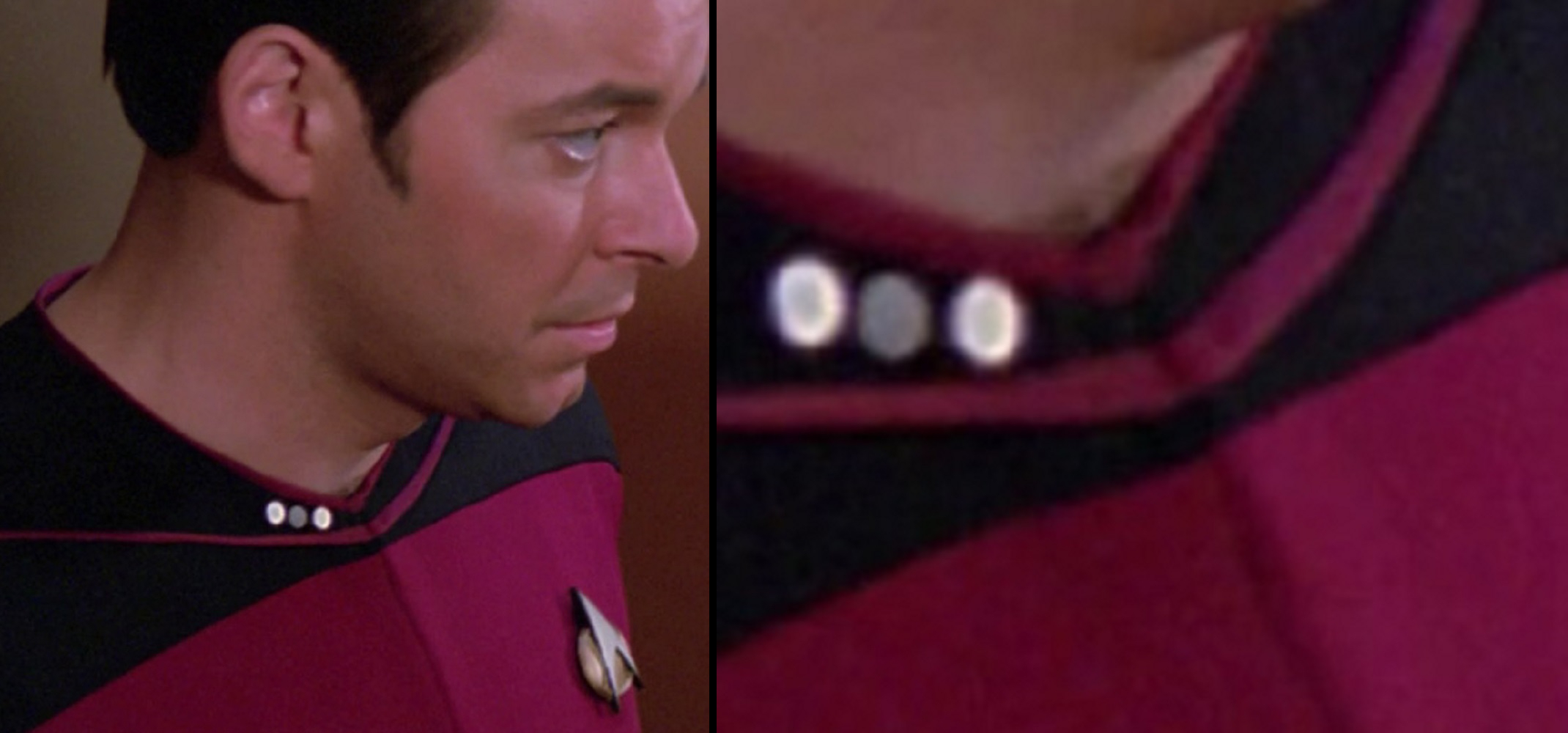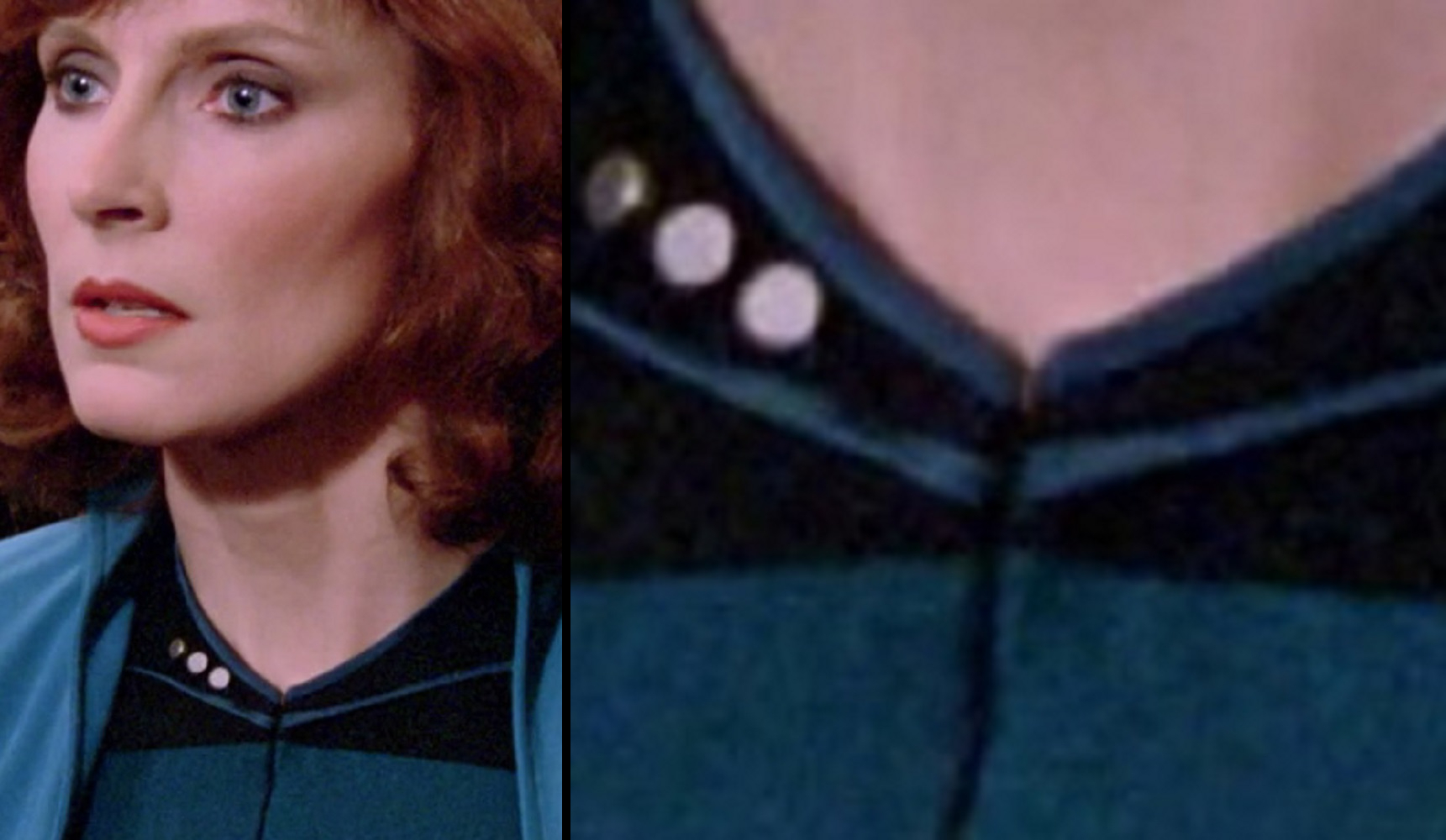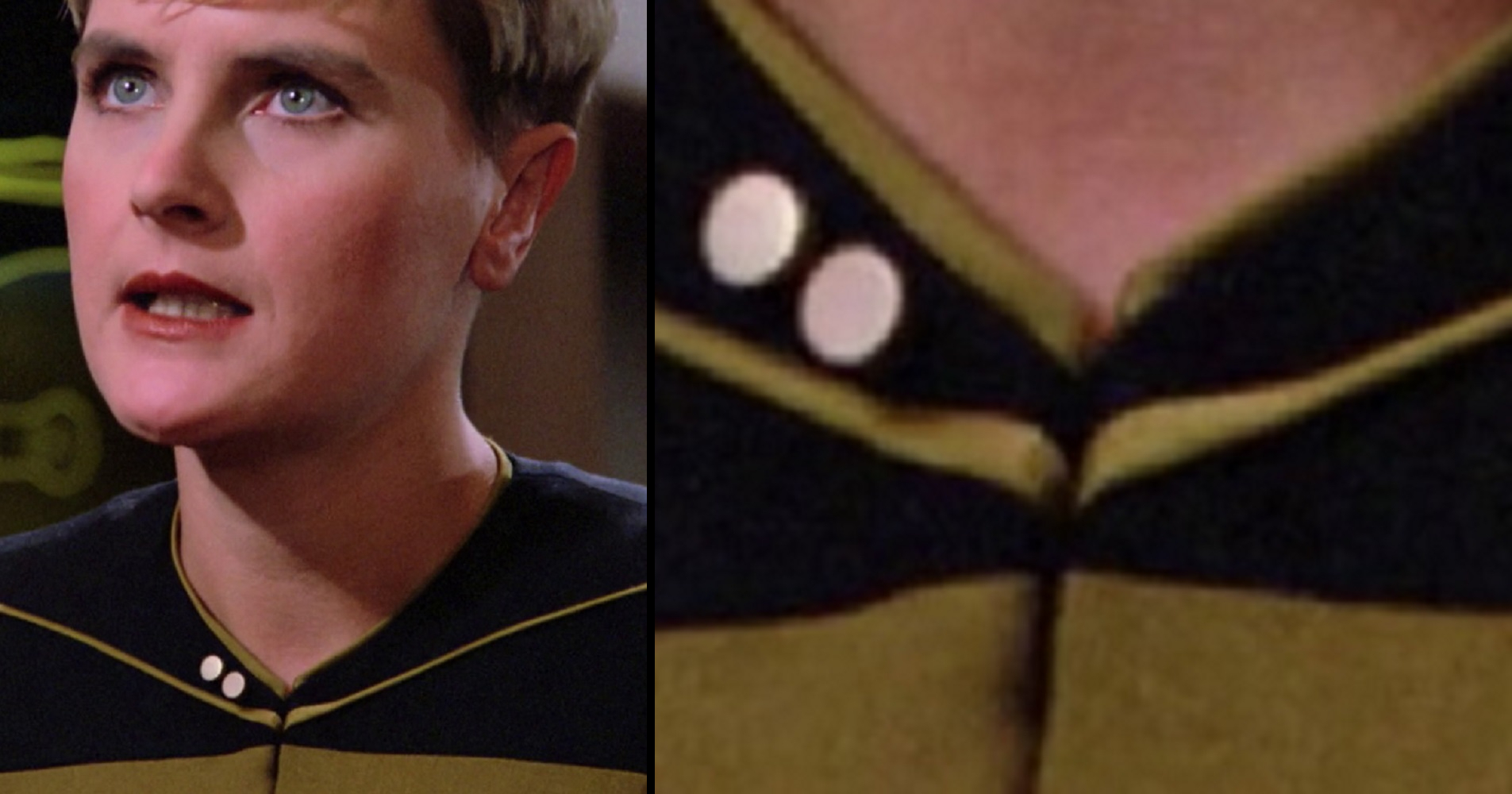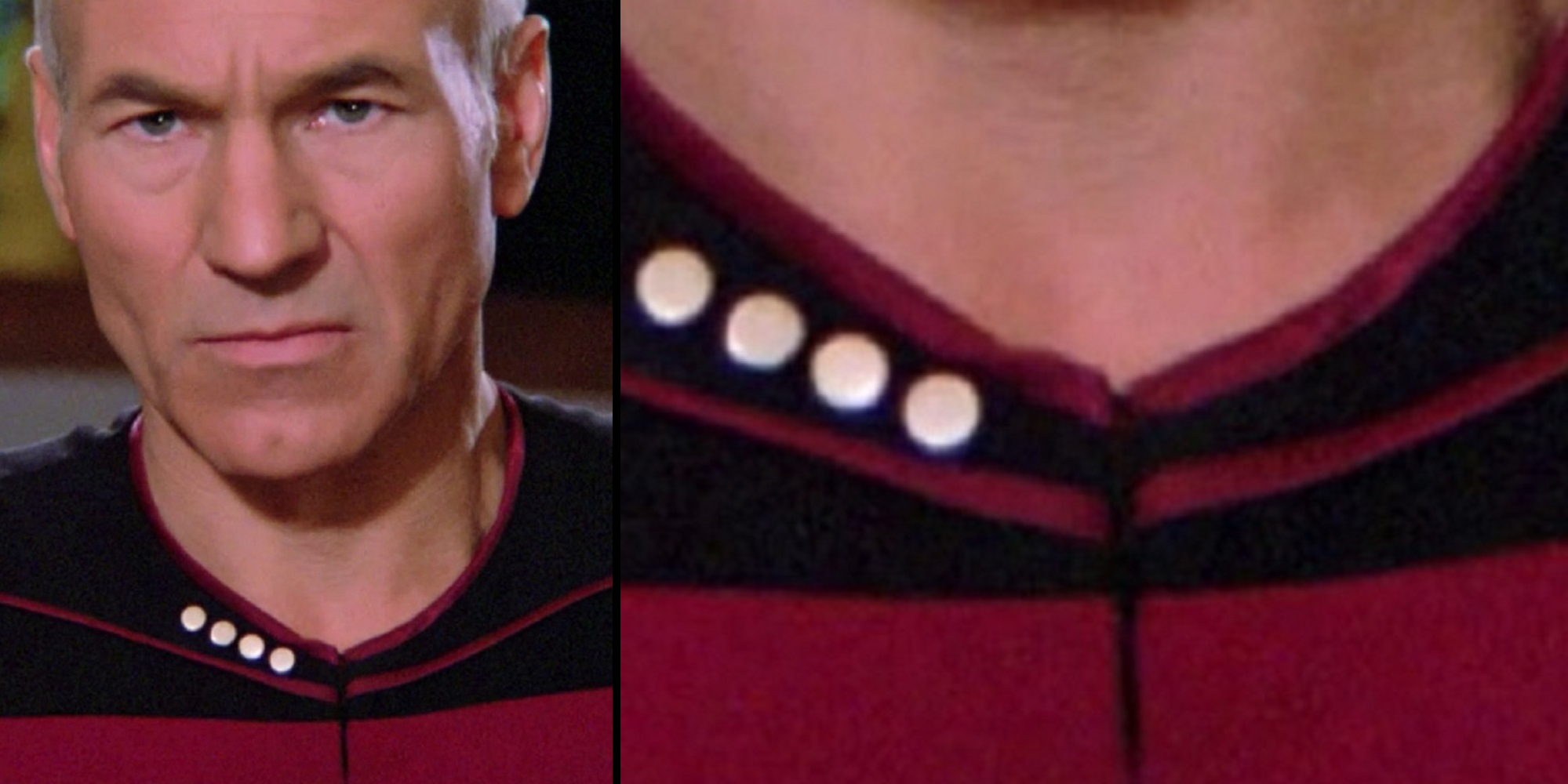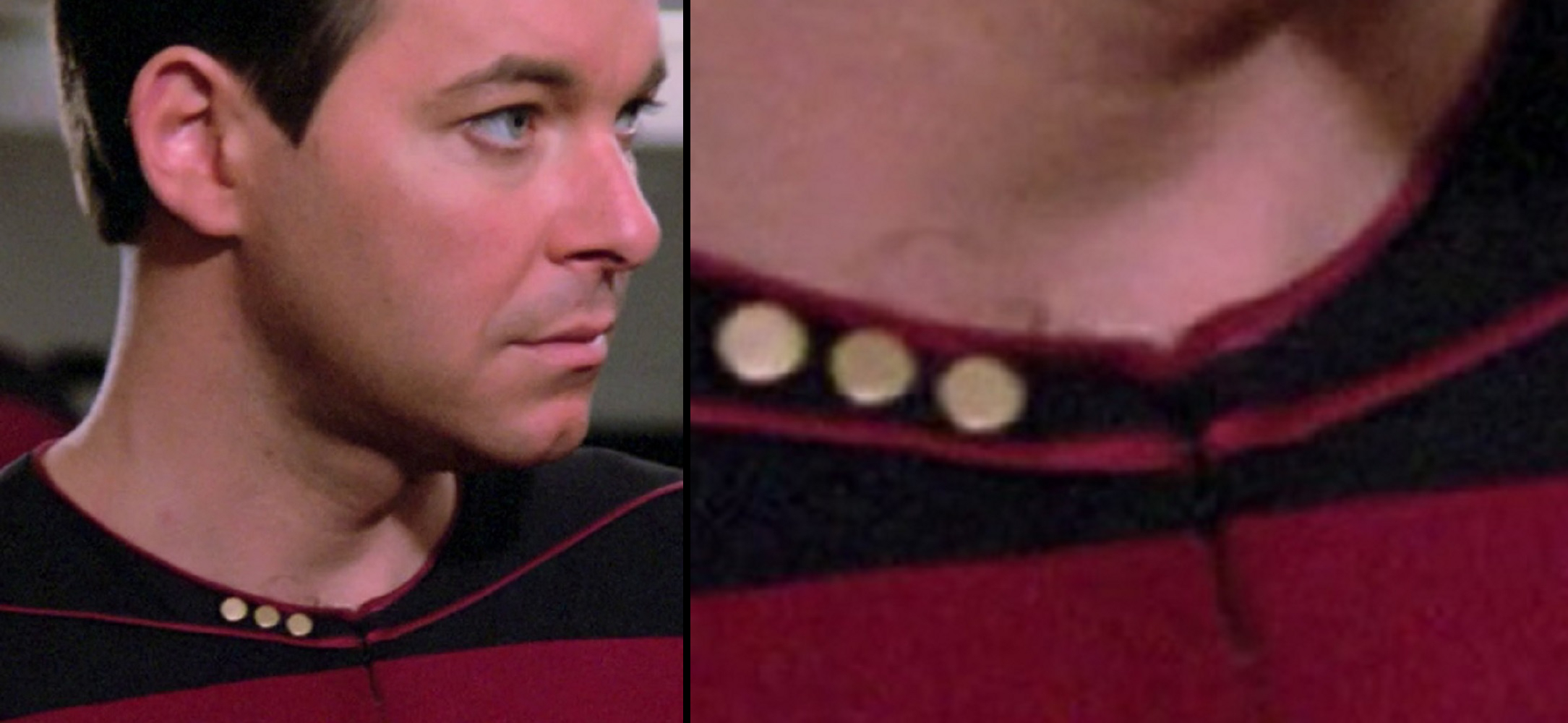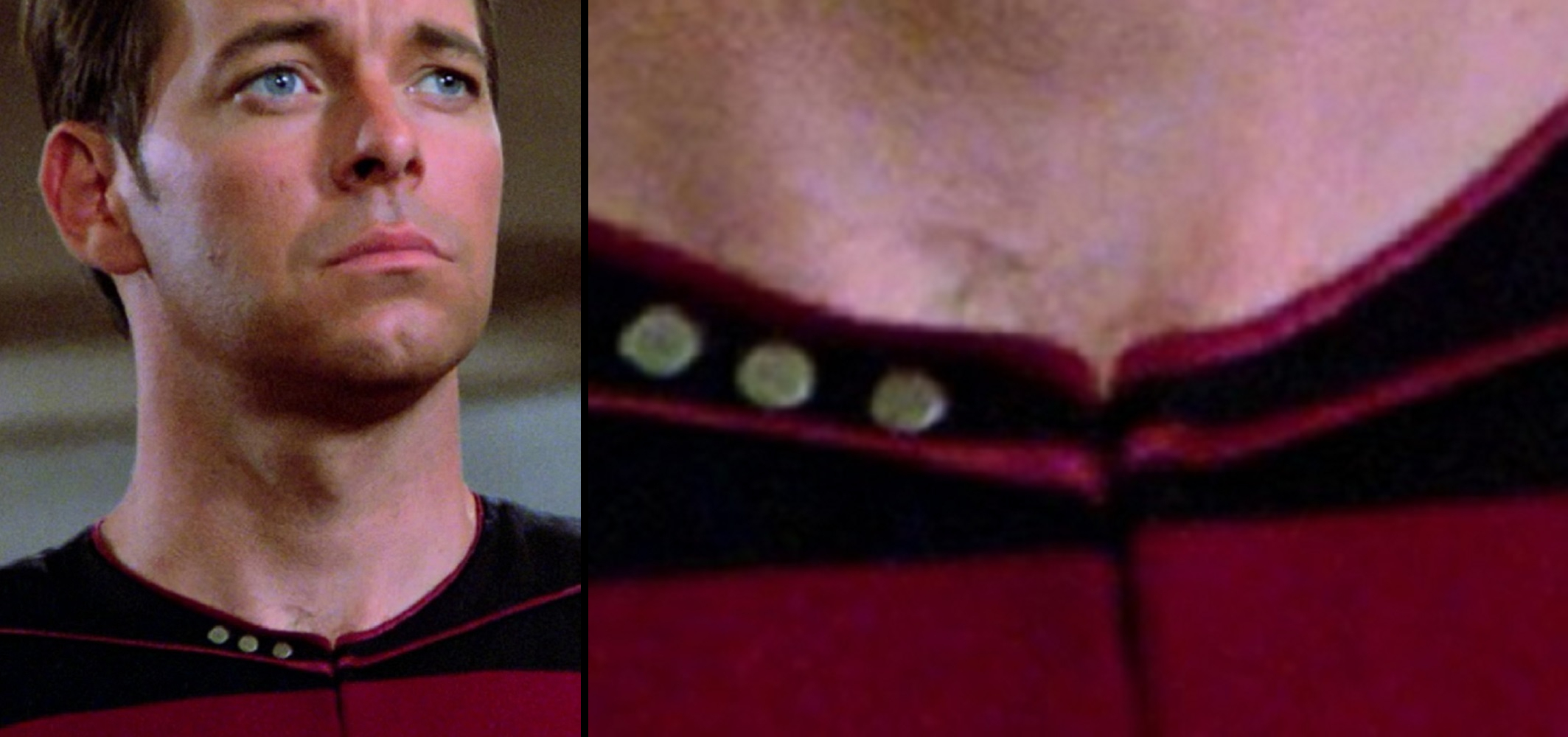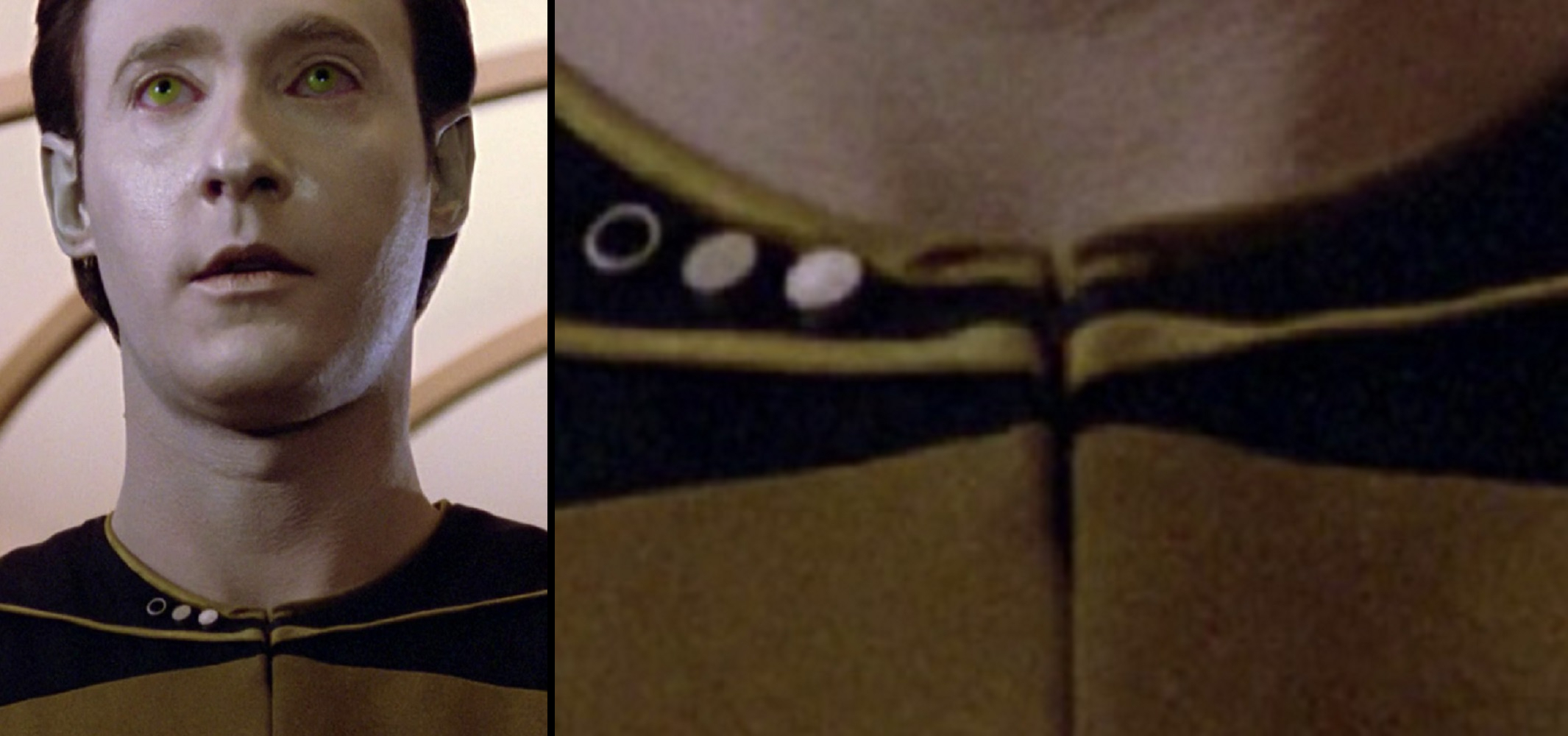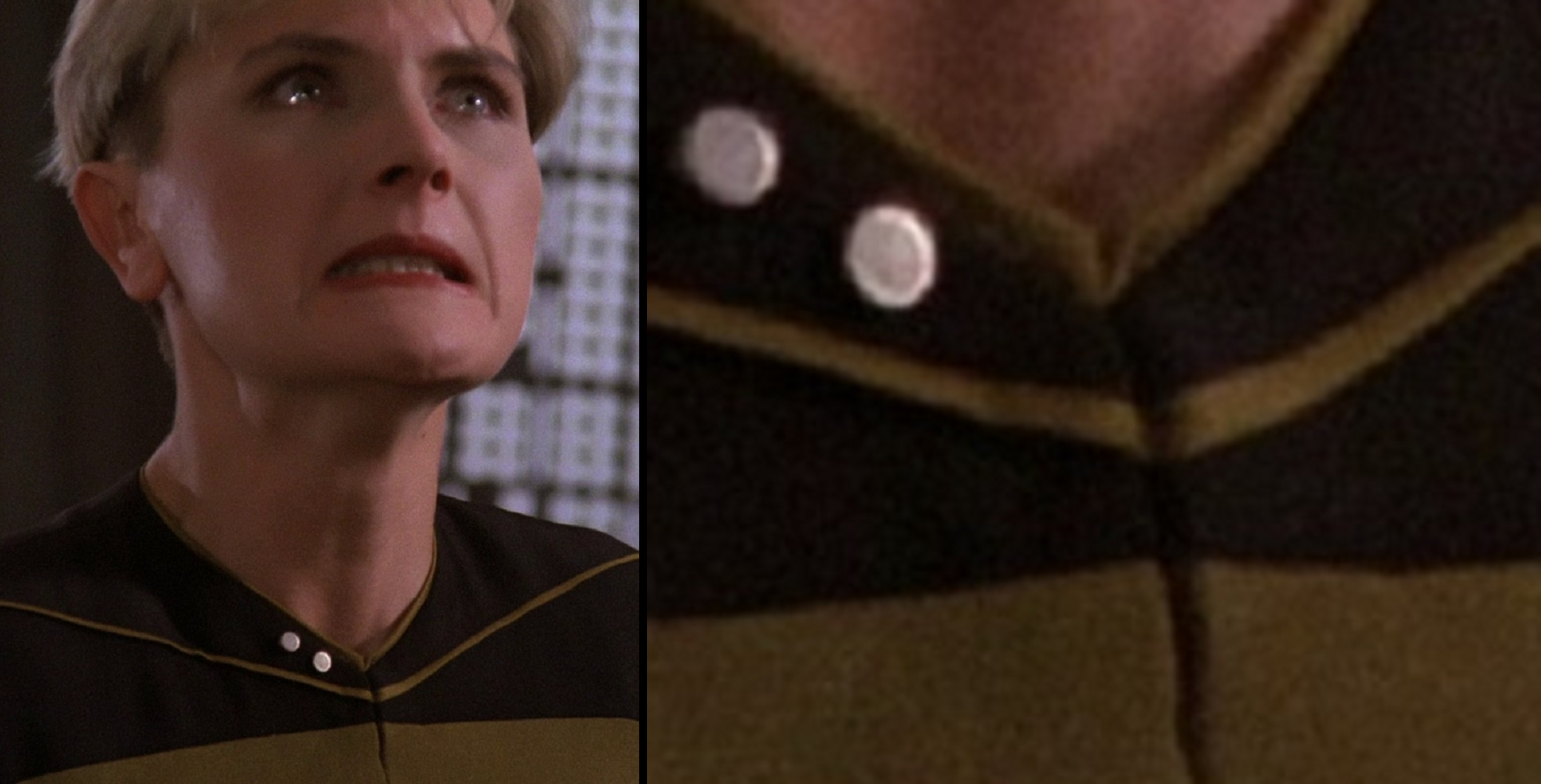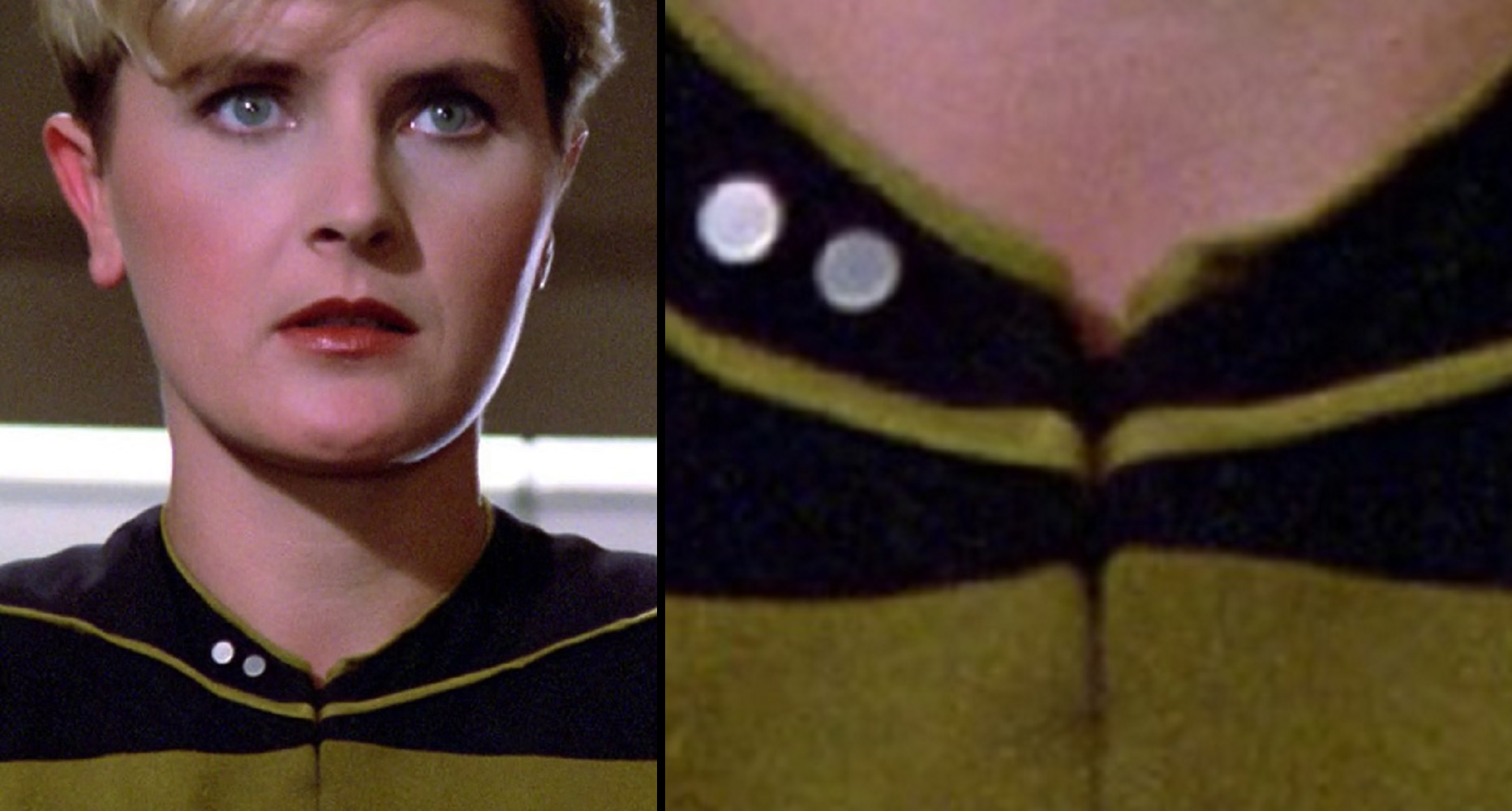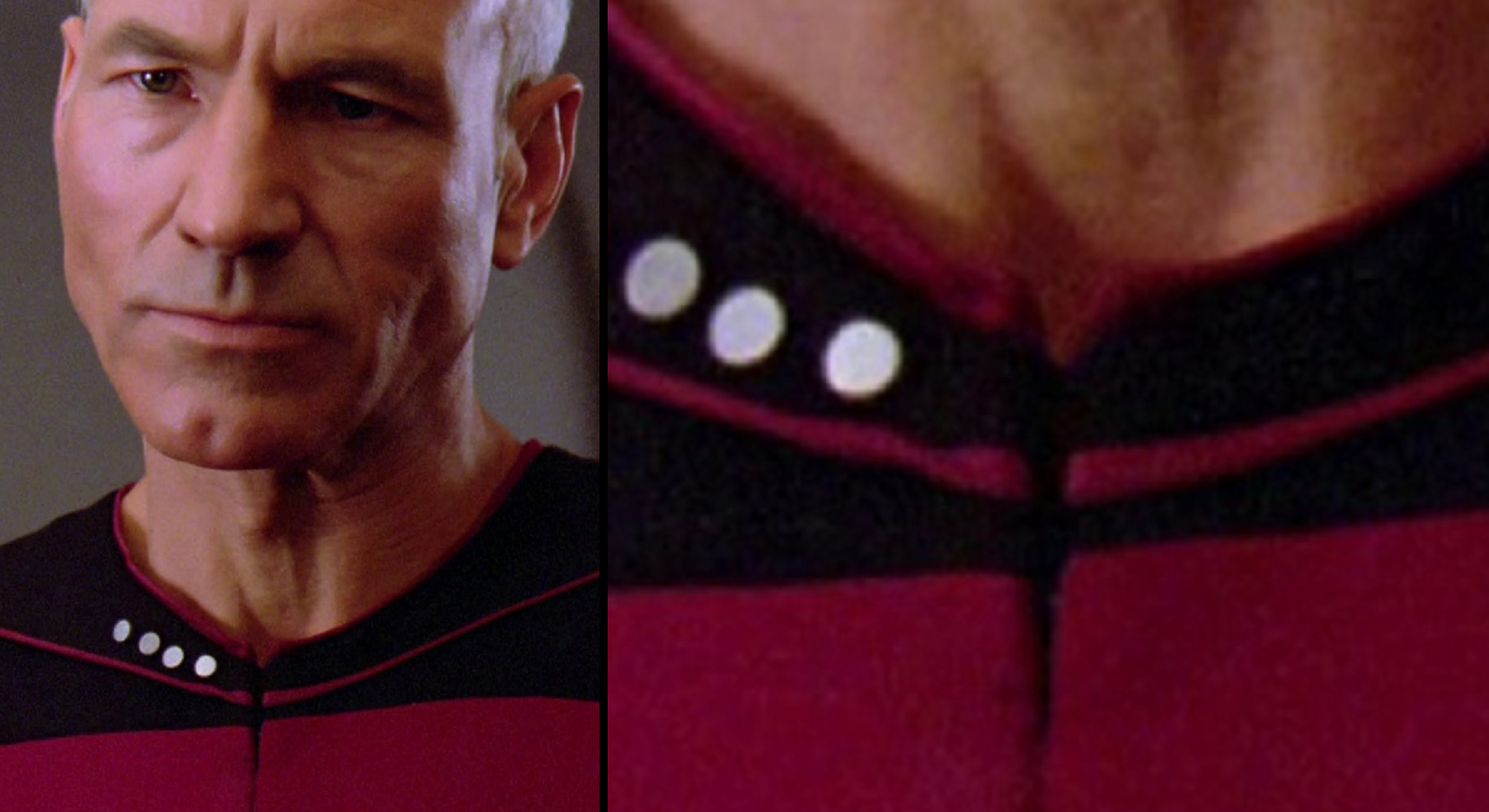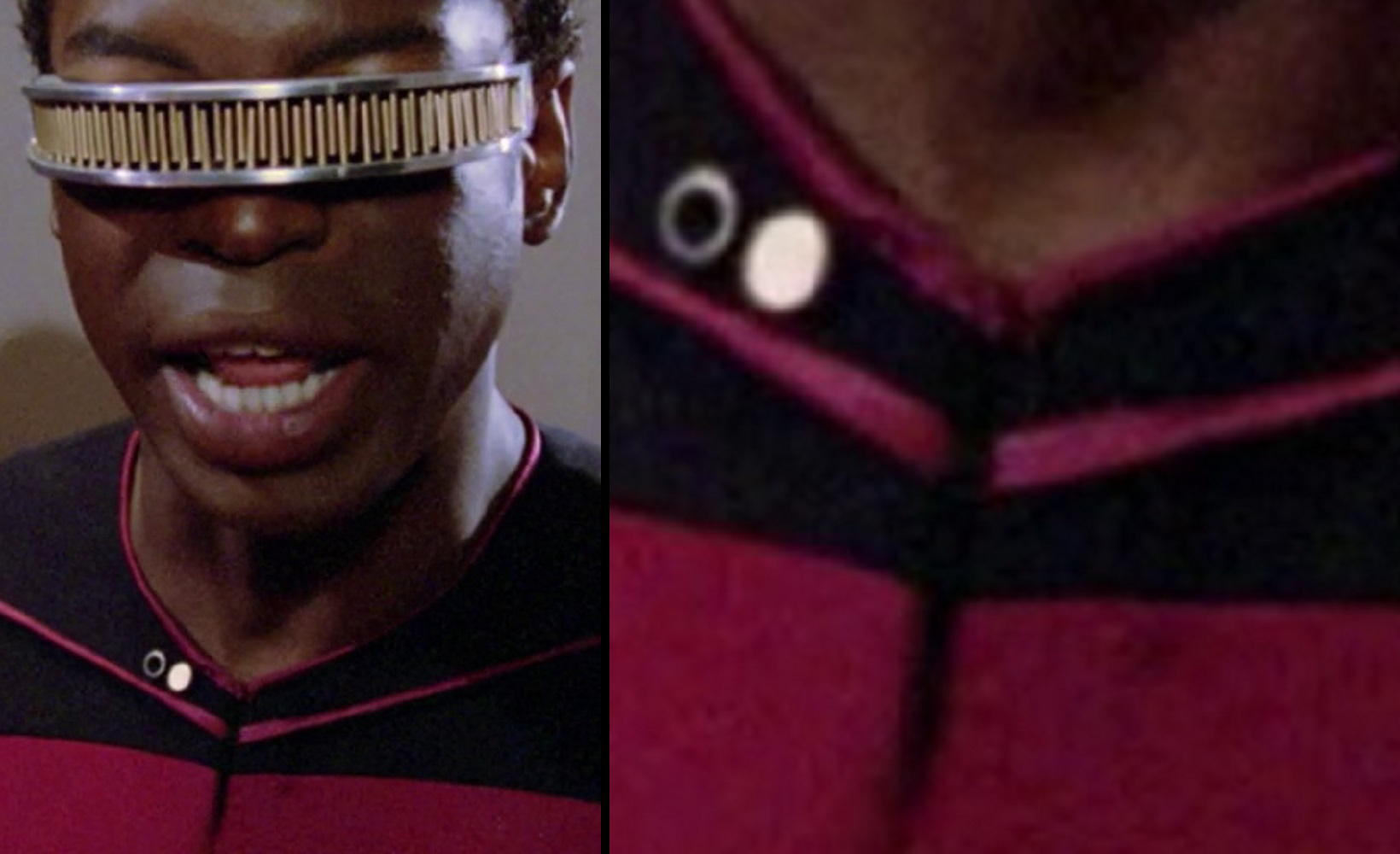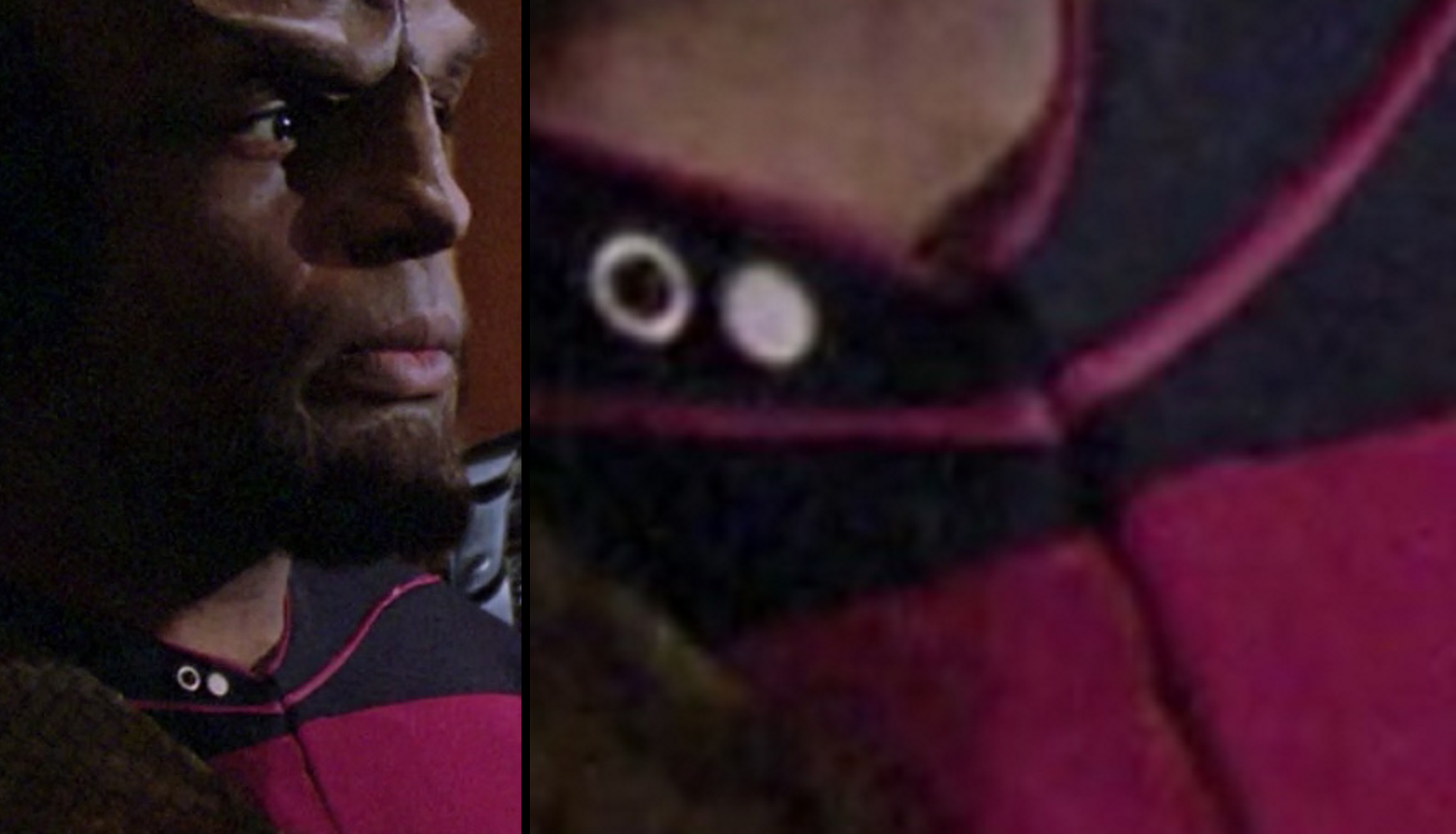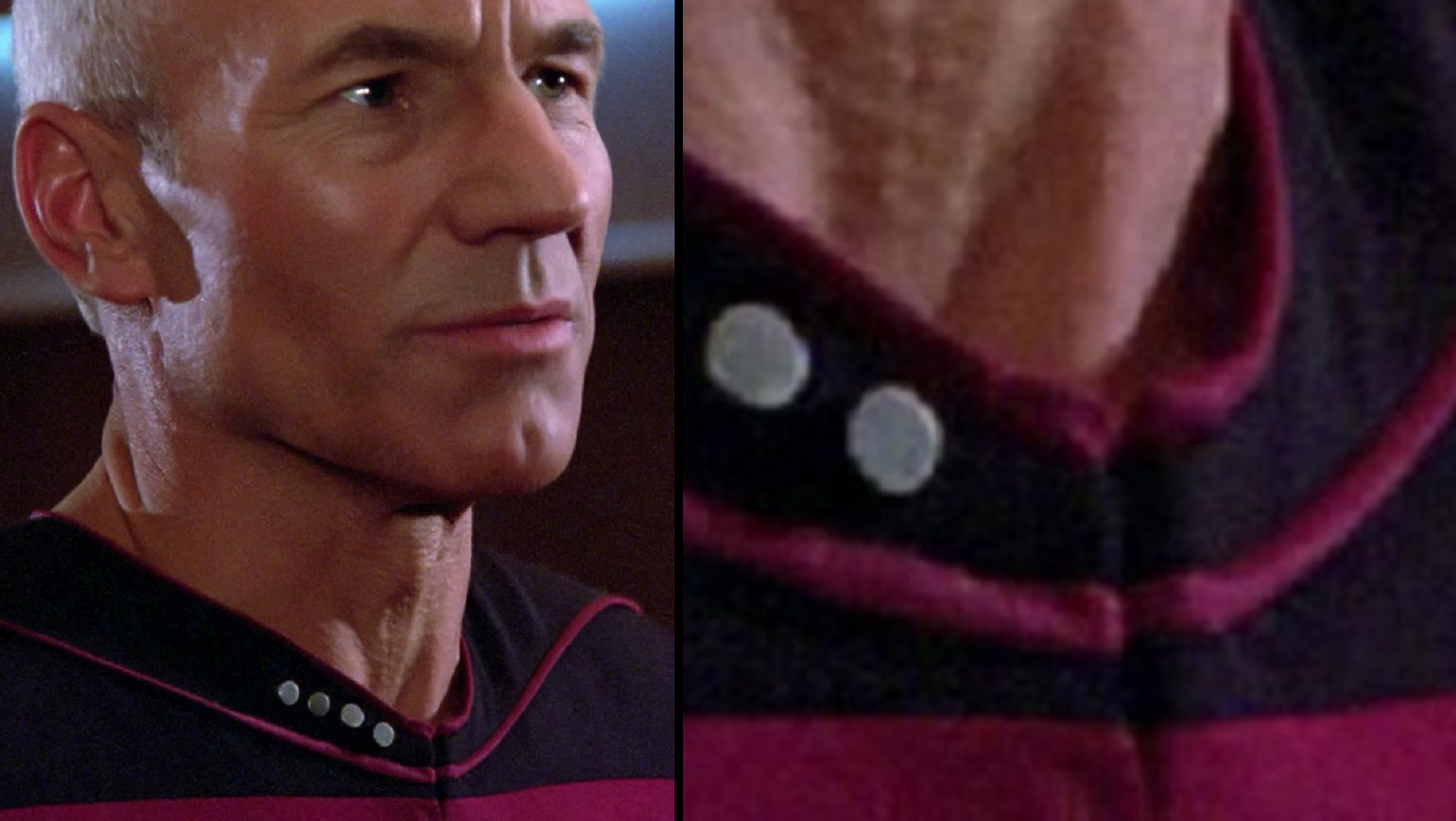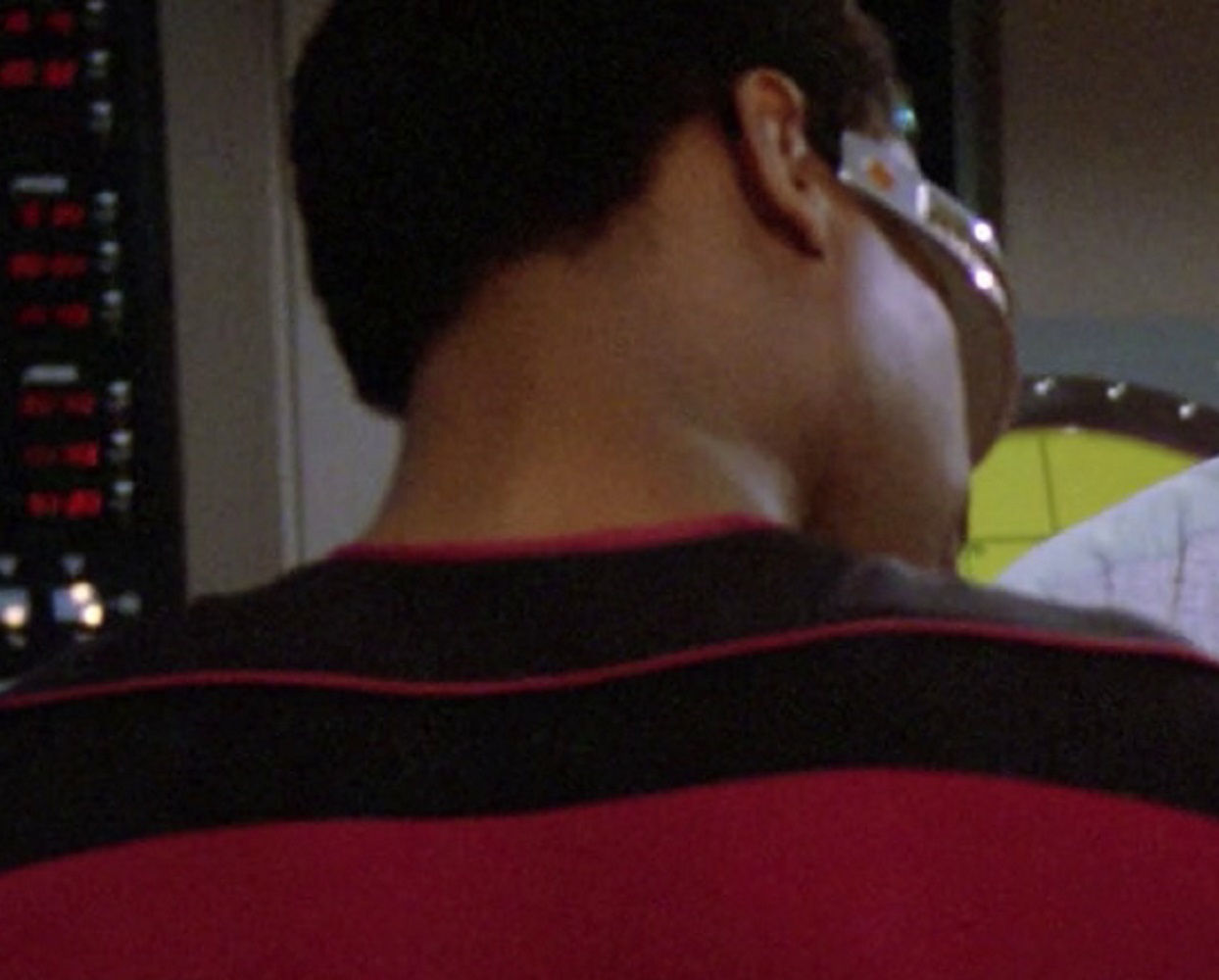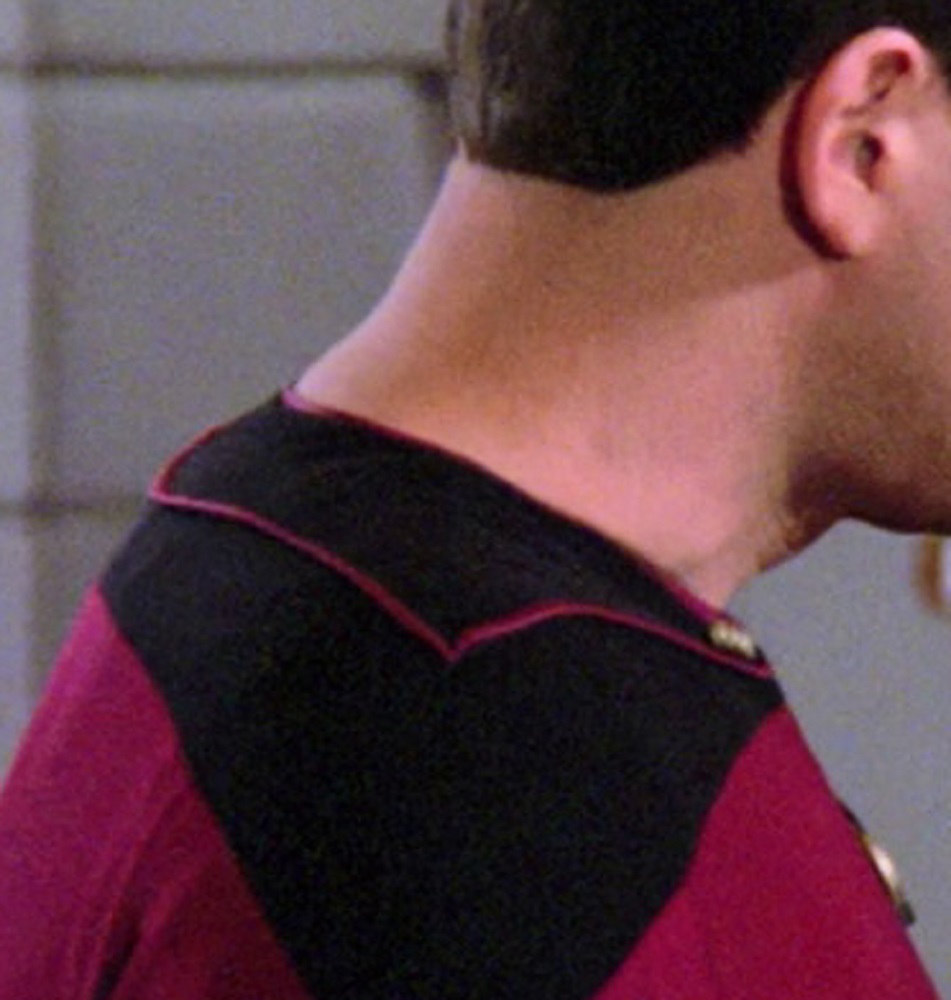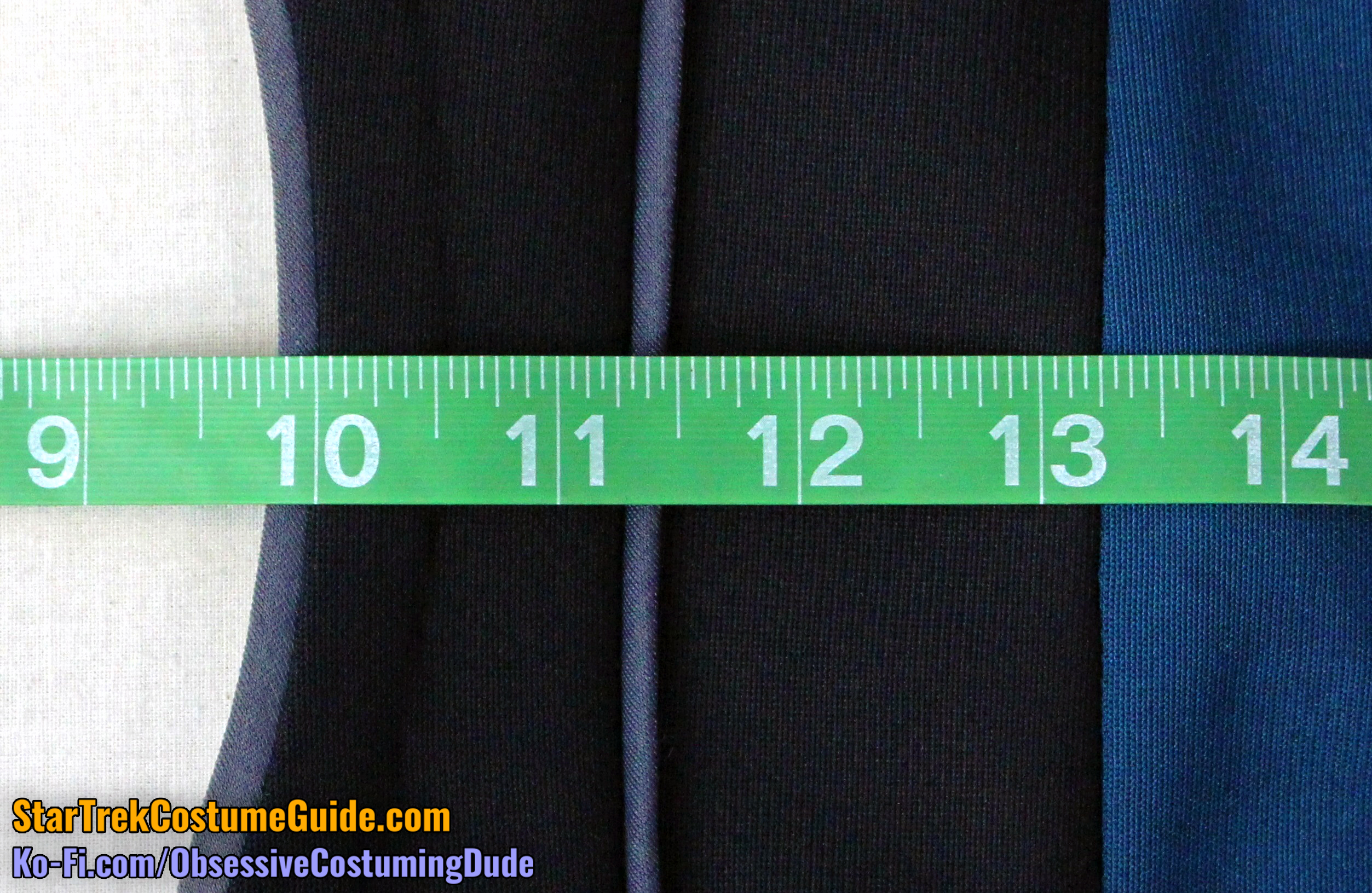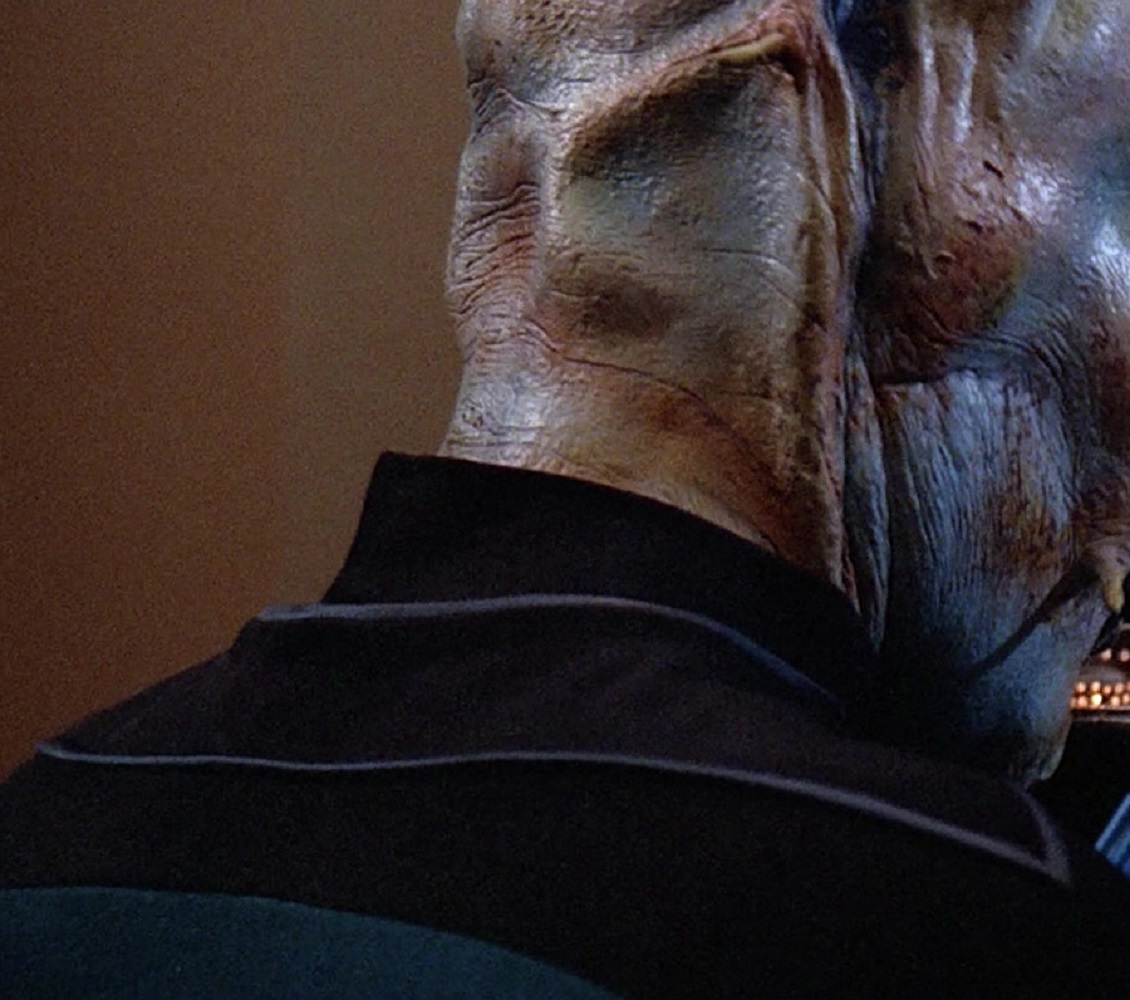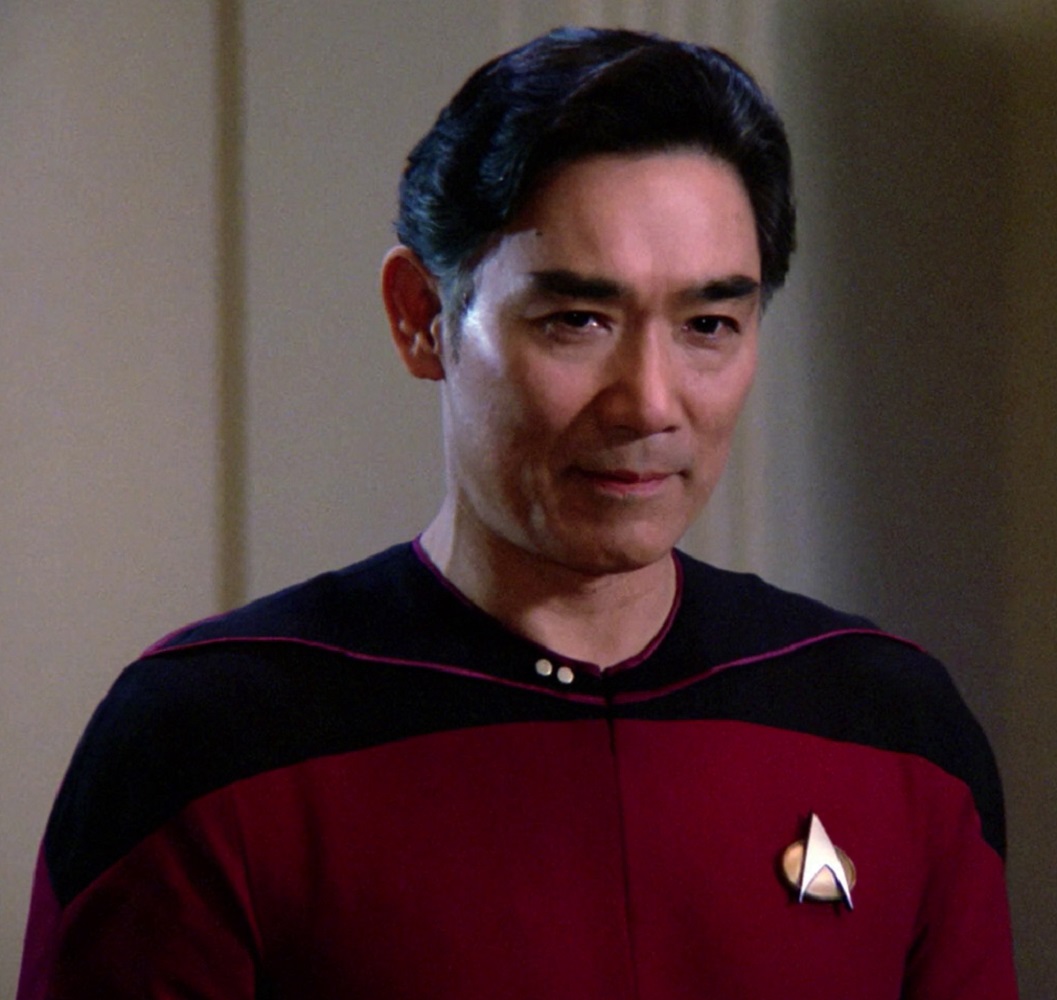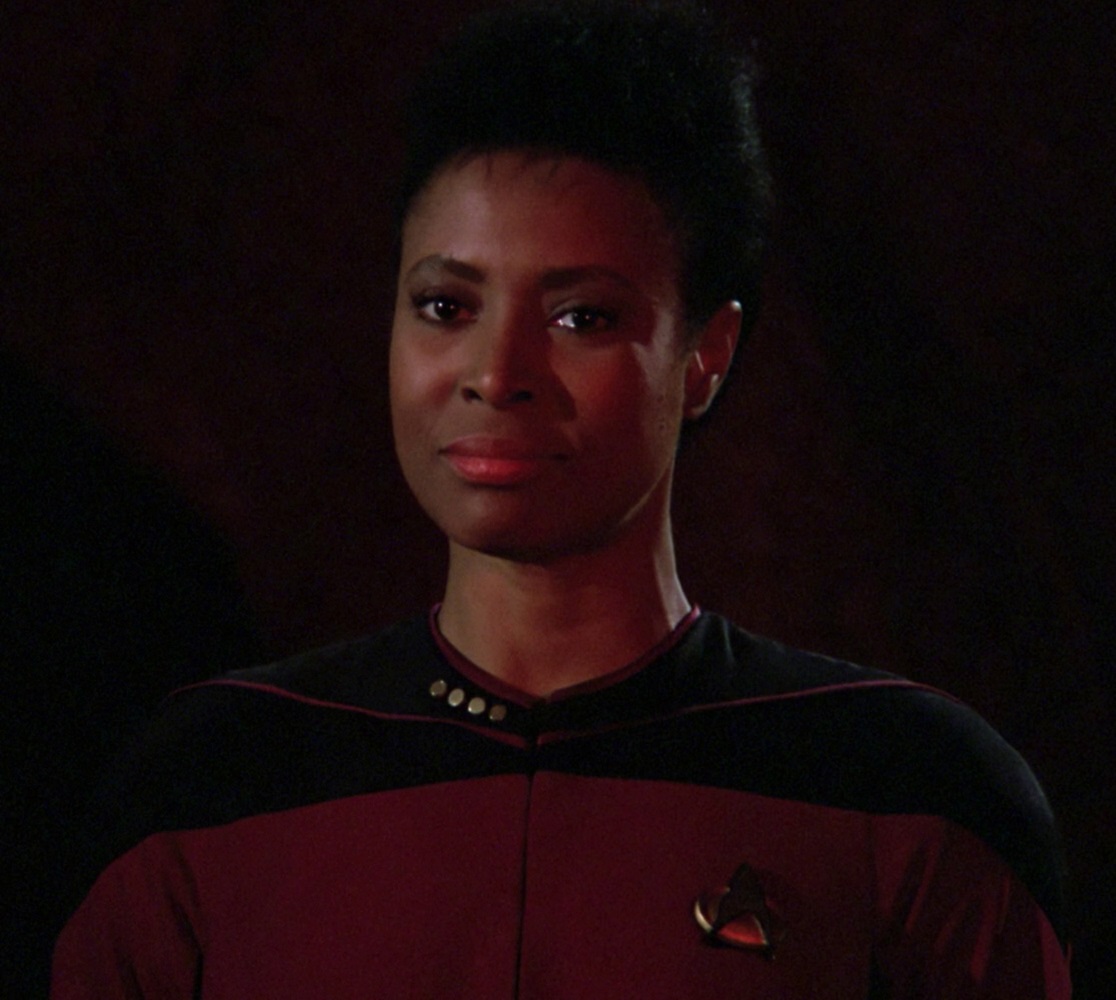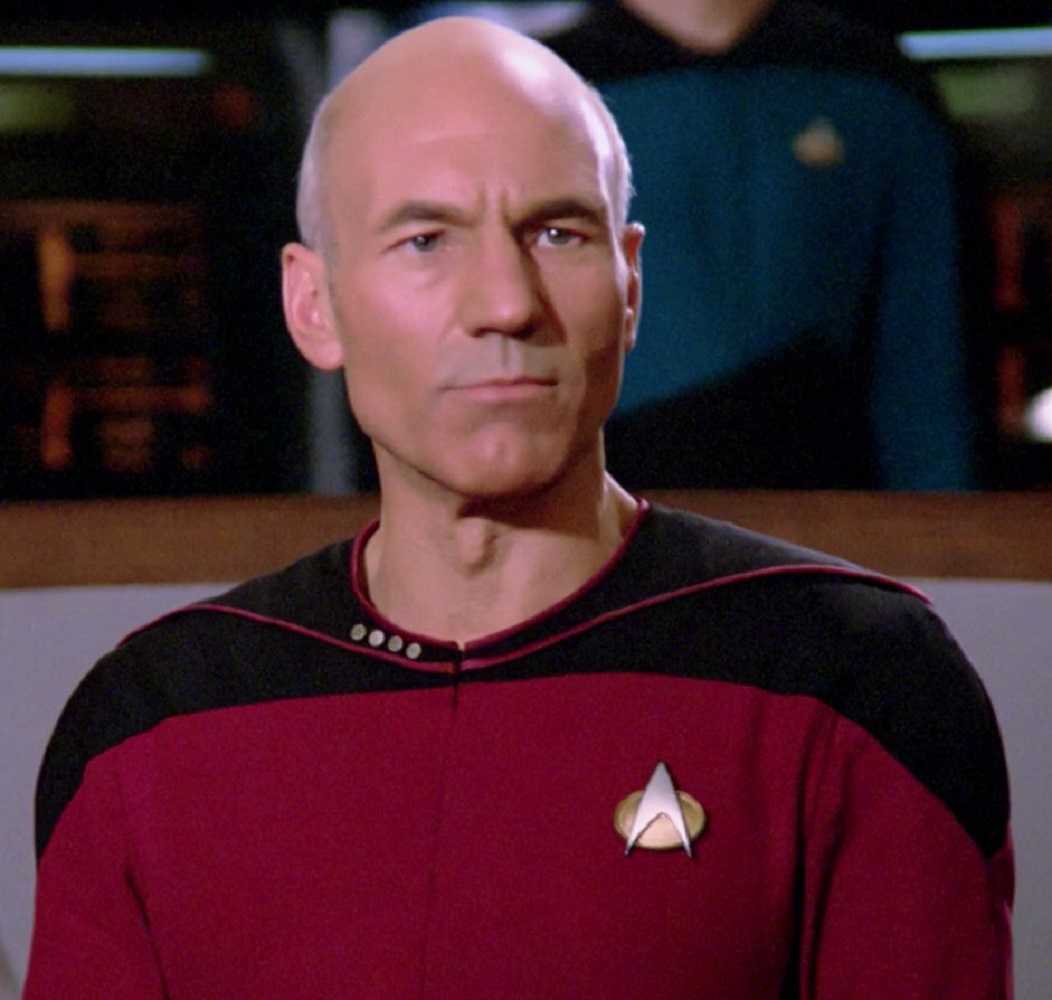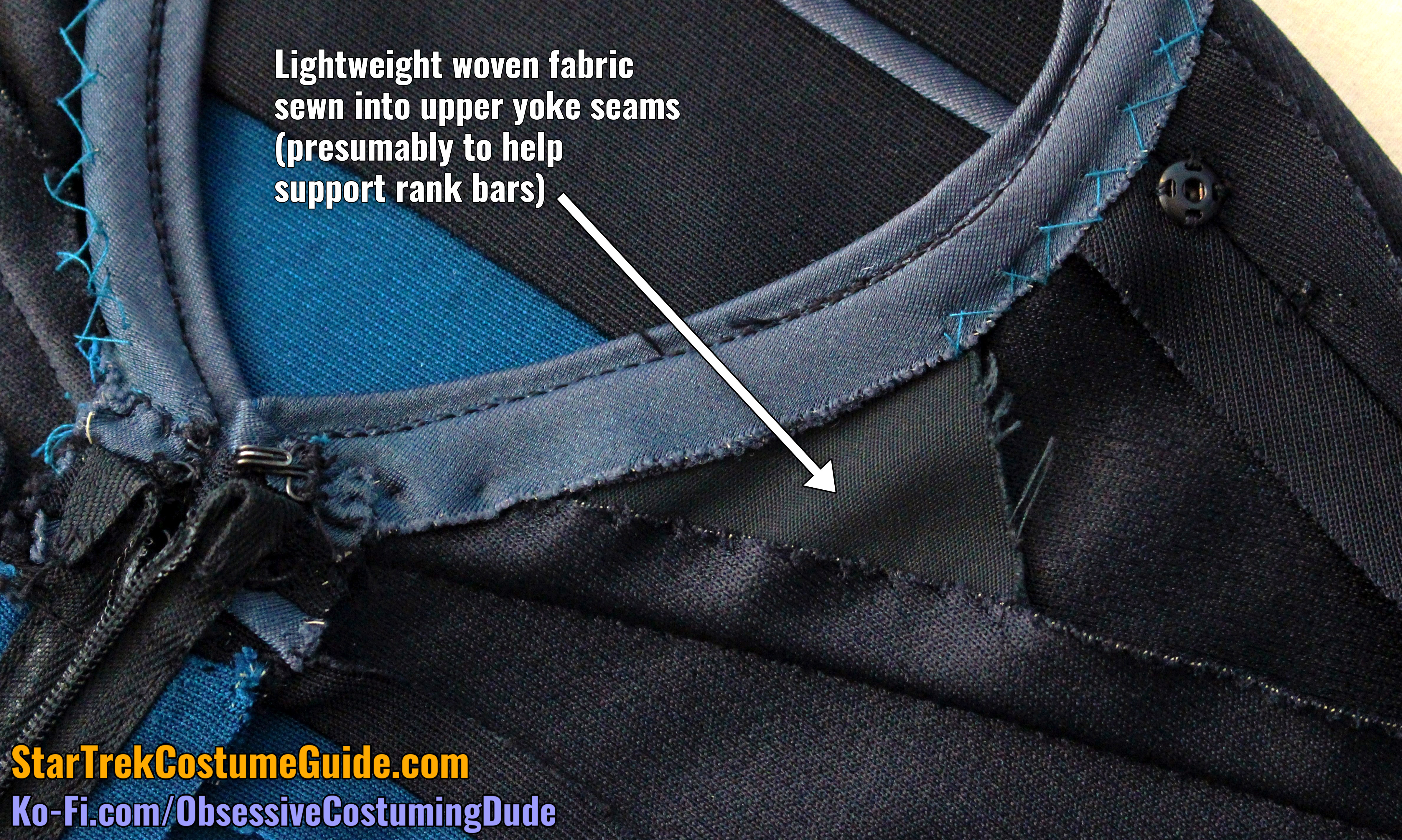Yoke Piping
The front yoke piping appears to have followed the general contour of the human clavicle (“collarbone”).
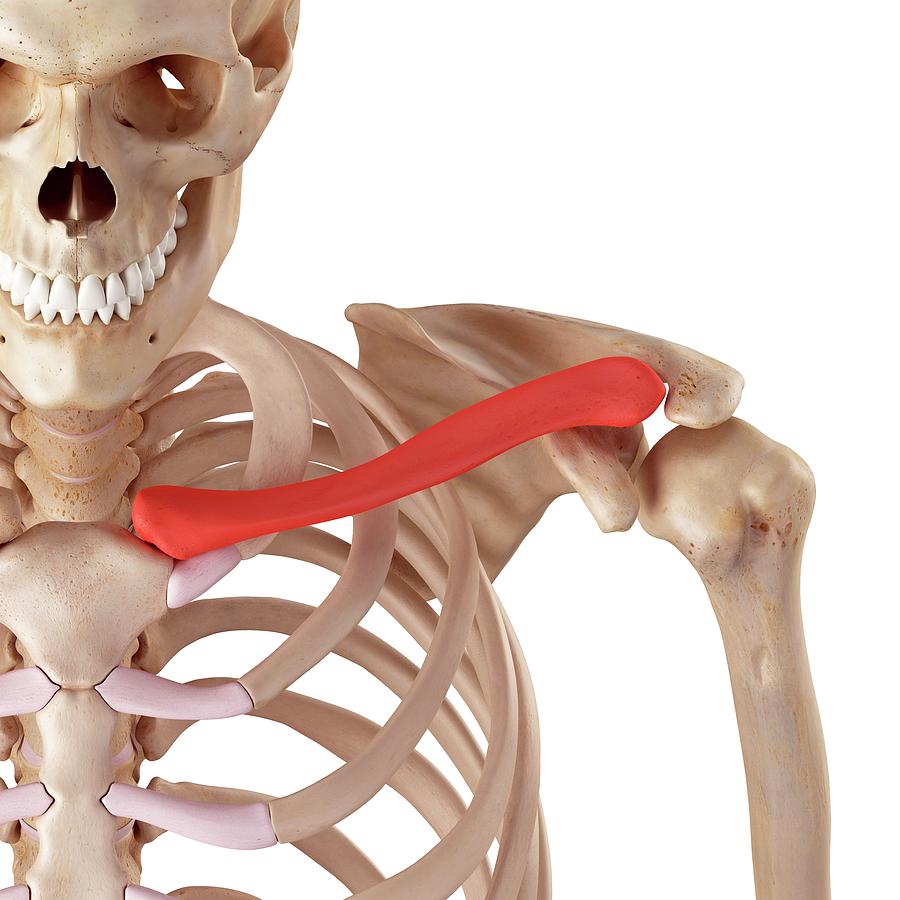
Interestingly, the front yoke seam was patterned only with the gentlest curves; here you can see the front yoke piping looked almost straight while the screen-used Tasha Yar TNG jumpsuit I examined was lying flat on the table:
But with this same jumpsuit on the dress form, you can see that the yoke piping pulled into that gentle double-curve mostly on its own.
The back yoke piping only had the slightest of curves, from the center back gently upward toward the shoulders.
The front and back yoke piping properly aligned at the jumpsuit’s shoulder seams.
Yoke Piping Width
Like the neckline trim, the yoke piping also appears to have been intended to be precisely 3/16” wide.
That said, the yoke piping did sometimes vary slightly in width – again, plus or minus about 1/16”.
Like the neckline trim, I believe it reasonable to assume that 3/16” was (at least eventually) the ideal standard width for the yoke piping.
And again like the neckline trim, sometimes the yoke piping appeared to be just a narrow ⅛” sliver or so, especially early in the season (and when those uniforms were rotated back into production) and on Data’s uniforms.
Other times, the yoke piping looked a little bit wider than normal – closer to ¼”.
To a minor extent, some of this may have been the result of an optical illusion; viewing the yoke piping from the wearer’s profile, one side might appear narrower while the other side appeared wider.
However, I believe much of this variation to have been some combination of William Ware Theiss’ experimentation and/or evolving design, and minor construction inconsistency in the wardrobe department.
Yoke Piping Construction
Like on the screen-used TNG skant I examined, the jumpsuit yoke/piping seam allowances seem to have usually been ⅜”, although they were ½” on the screen-used Dr. Crusher TNG jumpsuit I studied.
On the screen-used Worf TNG jumpsuit I examined, the yoke/piping seam allowances were actually hand-sewn together along the center front area.
In any event, the yoke/piping seam allowances were pressed upward, with the piping fabric extending downward underneath the seam.
Although it usually lay relatively flat, sometimes the piping fabric “fanned” upward a bit.
And sometimes the yoke piping was fussy and “warbly” – twisting upward, not wanting to lie completely flat.
Neckline/Yoke Trim Fabric
As I mentioned, the neckline/yoke trims was made from a lightweight spandex fabric that was a close (but from what I’ve seen, never exact) match to the corresponding jumbo spandex.
The neckline/yoke trims were often noticeably shinier than the jumpsuit body fabric.
The red fabrics were the closest color matches and usually “read” about the same in the show, but sometimes the difference was apparent:
The teal fabrics seem to have been the most commonly mismatched – again, especially in season two.
However, this may have been the result of ongoing production use, rather than by design.
Although the visible neckline/yoke trim was lavender-gray (!) on the screen-used Dr. Crusher TNG jumpsuit I examined, the same fabric was actually teal where it was sewn into the seams.
It believe this neckline/yoke trim fabric was probably not very lightfast, and much of the yellow was “baked” out of it under the bright, hot filming lights.
This accounts for the aforementioned screen-used Dr. Crusher TNG jumpsuit I examined, as well as the increasing examples of teal color discrepancies in season two (since the neckline/yoke trim would be teal initially but fade over time).
I’m not sure why the neckline/yoke piping fabric wasn’t the same division-colored jumbo spandex as the jumpsuit body (this this would practically guarantee an exact color match), but I see four possibilities:
1 – The powers that be believed jumbo spandex used in this manner would produce too much bulk, so a lightweight spandex was used instead to avoid bulking up these areas.
2 – These colors were simply the best matches achievable using the pre-dyed retail fabrics available at the time.
3 – Both fabrics were dyed simultaneously, but they took the dye differently.
4 – They were never intended to match for some reason.
Personally I believe it was probably a combination of the first two and I find the last theory unlikely, but who knows?

Yoke Depth
The center front yoke depth (in relation to the neckline/yoke trim and lower seam) was generally consistent throughout season one, although it did fluctuate a bit and would continue to deepen in season two.
I believe the ideal yoke depth to have been ⅞” at the center front, with the yoke trim vertically positioned halfway between the lower edge of the neckline trim and the lower yoke/body seam.
There were quite a few exceptions (which we’ll look at momentarily), but overall this seems to have been the standard throughout most of the first season.
That said, there were a handful of uniforms that appeared to have slightly shallower yokes, with slightly tighter spacing – especially early in the season (particularly Commander Riker’s), and toward the end of the season when those early uniforms were rotated back into production use.
I believe these shallower yokes to have probably been the result of “human error” during the construction process; again, I can attest to the challenge of controlling multiple layers of spandex to within such a tight margin.
A more common variation was slightly deeper yokes – for example, the yoke on the screen-used Dr. Crusher TNG jumpsuit I studied measured 1 ¼” deep at the center front.
These slightly deeper yokes were seen as early as the first couple episodes.
However, they yokes were most consistently seen on some of Tasha Yar’s uniforms throughout the season.
Tasha’s uniforms notwithstanding, these slightly deeper yokes were primarily seen on the second batch of costumes, which entered production use after the first half-dozen episodes or so – particularly Captain Picard’s uniforms during the second half of the season.
Commander Riker’s second round of uniforms (with slightly deeper yokes) were similarly timed but not seen as consistently throughout the season.
Dr. Crusher’s uniform timeline appears to have been the same as Data’s in this regard, but as with the neckline, it’s tough to say for certain.
Geordi’s uniforms with the deeper yokes were more consistently seen during the second half of the season.
Worf’s deeper yokes seem to have been introduced around the same time as Riker’s, Data’s, Geordi’s, and Beverly’s, then were seen a bit later in the season – but again, it’s tough to say for sure.
There simply weren’t enough close-up shots of Worf to make a clear determination, but considering the context of the rest of the cast, I think it’s probably a safe bet his followed a similar timeline as most of the others.
Like his successors, Theiss didn’t miss a chance to “field-test” design experiments with guest characters, minor supporting characters, and other relatively low-risk opportunities.
In this case, the slightly deeper yokes were seen on several supporting characters late that first season.
As best I could tell, Captain Tryla Scott’s uniform had the deepest yoke we saw that season.
Despite the previous yoke examples having various depths at the center front, the yoke piping was always (more or less) vertically-centered.
However, a curious exception to this overall standard was for the yoke piping to be slightly lower (not vertically centered) in relation to the neckline.
The most notable example of this was Captain Picard’s uniforms, mainly seen during the middle of the season.
While I obviously can’t say for certain, I believe the relative spacing of the yoke piping to have been an unintentional result of some other factor – possibly the raising of the neckline (as I mentioned earlier, these were less V-shaped and more rounded) without proportionately raising the yoke piping to compensate.
At least a couple of Data’s uniforms had slightly offset yoke piping at the center front, although I believe the effect to have definitely been inadvertent in these examples.
Lieutenant Chang’s and Fake Captain Rice’s uniforms had slightly offset yoke piping at the center front as well, although I believe their uniforms may have been intentionally modified like Captain Picard’s were.
What to make of all this?
Well in summary, my interpretation is as-follows:
I believe an ideal yoke depth of ⅞” (with the yoke piping vertically centered) to have been originally intended.
A few uniforms varied a bit early on, as the costume department was getting the hang of things.
The second batch of cast uniforms had slightly deeper yokes – perhaps because Theiss decided he wanted to try a design with slightly deeper proportions at the front, or perhaps because the wardrobe department determined it was easier to give themselves a bit more “wiggle room” in that area?
But whatever the reason may have been, the yoke piping was still vertically centered …
… except on at least one (but not all) of Captain Picard’s uniforms, primarily used during the middle of the season, and a couple guest characters’. (Again, my theory is that the necklines may have been altered, without proportionately adjusting the positioning of the yoke piping to compensate.)
All the while, the first batch of uniforms was still getting occasional use, in rotation with the second batch.
Remember that Theiss also altered the necklines on many of the uniforms in that second batch too, so I see this as clear evidence that he was already tinkering with his uniform design.
Back Yoke Piping
The center back positioning of the yoke piping was somewhat inconsistent.
Sometimes one edge or the other appears to have been vertically centered at the center back.
Lower Yoke Seam Curve
This was particularly true on Tasha’s and Geordi’s uniforms.
However, this lower yoke/ body seam actually curved gently downward away from the center front.
In addition to my own photos, in this shot you can actually see the seam curve in relation to the horizontal jumbo spandex weave.
The lower back yoke/upper body seam was similarly curved.
Once one knows to look for it, the slight curve along the lower edge of the yoke is easy to observe.
Among the cast, Geordi’s jumpsuits probably had the least-curved seams.
Conversely, Data’s jumpsuit yokes tended to have the strongest lower curves – possibly because Brent Spiner appears to have particularly sloped shoulders.
Indeed, some of Data’s jumpsuit yokes dropped off so sharply away from the center front as to form a slight upside-down V-shape, more angled than curved.
Indeed, some of Data’s jumpsuit yokes dropped off so sharply away from the center front as to form a slight upside-down V-shape, more angled than curved.
Toward the end of the season, it looks like Theiss and his team managed to make Data’s lower yoke seam more analogous to those on the other characters’ uniforms.
Spiner’s unusually sloped shoulders would continue to challenge Theiss’ successors all the way through Insurrection; by Nemesis, costume designer Robert Blackman finally managed to straighten Data’s lower yoke seam a bit.
This issue wasn’t confined to Data’s uniforms; some other characters’ lower yoke seams were more sharply angled, too.
Lower/Outer Yoke Corners
Another element of the jumpsuit yokes that varied was how low the outer corners extended onto the sleeves.
Initially they only curved slightly downward, but with the second round of uniforms introduced a half-dozen or so episodes into the season, the lower/outer corners of the yokes dipped noticeably lower – particularly on Captain Picard’s uniforms.
Here’s a closer, side-by-side comparison of the above examples.
The design of Data’s uniforms appears to have been similarly altered partway into the season.
Perhaps it was just Michael Dorn’s burly build, but the lower/outer corners of his jumpsuit yokes never seemed to dip as low as some of the others did.
The net result of all this “consistent inconsistency” was a relatively standardized approach that evolved and produced interesting, subtly-different yoke variations among the cast.
For example, Frakes/Riker and Dorn/Worf are large fellows, yet in the overall scheme of the uniform their yokes appear to proportionately be fairly shallow overall.
Worf’s jumpsuit yoke, in particular, looked like an insubstantial sliver of black over his red torso fabric.
On the other hand, Tasha’s and Geordi’s jumpsuits had yokes that appeared deeper by comparison, with a heavier “concentration” of black at the top of their uniforms.
With all this in mind, you can probably also see why I believe Commander Quinteros’ jumpsuit to have been one of Commander Riker’s early uniforms:
Yoke Interfacing
The upper right front yoke area was at least sometimes interfaced – presumably to both help stabilize the yoke fabric for the rank bars, and to support the rank bars themselves.
On the screen-used Tasha Yar TNG jumpsuit I studied this area had a layer of fusible interfacing.
On the screen-used Dr. Crusher TNG jumpsuit I studied this area was backed with a layer of lightweight woven fabric (sewn into the seam).
And on the screen-used Worf TNG jumpsuit I studied the area wasn’t interfaced at all. (Poor Worf never really got the respect he deserved on TNG, did he?)
































